#Sogdians
Explore tagged Tumblr posts
Text
"Sogdians were skilled in commerce, diplomacy, literacy, art and entertainment, and were involved in the spread of several religions, as well as establishing their own religious traditions. They also played a crucial part in moving silk along the Silk Roads."
3 notes
·
View notes
Text


Sogdians in the Indian Ocean ⁉️⁉️
7 notes
·
View notes
Text
Зуев Ю. А. Ранние тюрки: очерки истории и идеологии (2002)

Зуев Ю. А. Ранние тюрки: очерки истории и идеологии (2002) https://www.avetruthbooks.com/2023/02/zuev-ju-a-rannie-tjurki-ocherki-istorii-i-ideologii-2002.html?feed_id=12678
#History#Cumans#HistoryofTurkey#HistoryofTurkicPeoples#Jalayirids#KangarKangly#Kangarâyê#Kangju#Kengeres#KimekKhaganate#RashīdalDīnFaḍlullāhHamadānī#Sogdians#TürgeshKhaganate#Wusun#YancaiAbzoae#Yuezhi
0 notes
Text
The most important deity you've never heard of: the 3000 years long history of Nanaya
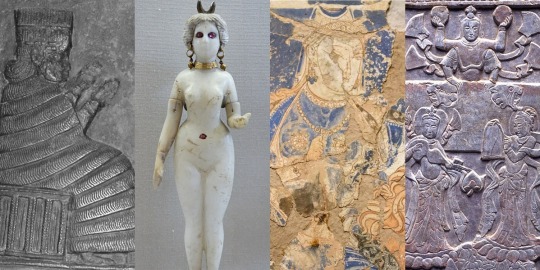
Being a major deity is not necessarily a guarantee of being remembered. Nanaya survived for longer than any other Mesopotamian deity, spread further away from her original home than any of her peers, and even briefly competed with both Buddha and Jesus for relevance. At the same time, even in scholarship she is often treated as unworthy of study. She has no popculture presence save for an atrocious, ill-informed SCP story which can’t get the most basic details right. Her claims to fame include starring in fairly explicit love poetry and appearing where nobody would expect her. Therefore, she is the ideal topic to discuss on this blog. This is actually the longest article I published here, the culmination of over two years of research. By now, the overwhelming majority of Nanaya-related articles on wikipedia are my work, and what you can find under the cut is essentially a synthesis of what I have learned while getting there. I hope you will enjoy reading it as much as I enjoyed working on it. Under the cut, you will learn everything there is to know about Nanaya: her origin, character, connections with other Mesopotamian deities, her role in literature, her cult centers… Since her history does not end with cuneiform, naturally the later text corpora - Aramaic, Bactrian, Sogdian and even Chinese - are discussed too. The article concludes with a short explanation why I see the study of Nanaya as crucial.
Dubious origins and scribal wordplays: from na-na to Nanaya Long ago Samuel Noah Kramer said that “history begins in Sumer”. While the core sentiment was not wrong in many regards, in this case it might actually begin in Akkad, specifically in Gasur, close to modern Kirkuk. The oldest possible attestation of Nanaya are personal names from this city with the element na-na, dated roughly to the reign of Naram-Sin of Akkad, so to around 2250 BCE. It’s not marked in the way names of deities in personal names would usually be, but this would not be an isolated case.
The evidence is ultimately mixed. On one hand, reduplicated names like Nana are not unusual in early Akkadian sources, and -ya can plausibly be explained as a hypocoristic suffix. On the other hand, there is not much evidence for Nanaya being worshiped specifically in the far northeast of Mesopotamia in other periods. Yet another issue is that there is seemingly no root nan- in Akkadian, at least in any attested words.
The main competing proposal is that Nanaya originally arose as a hypostasis of Inanna but eventually split off through metaphorical mitosis, like a few other goddesses did, for example Annunitum. This is not entirely implausible either, but ultimately direct evidence is lacking, and when Nanaya pops up for the first time in history she is clearly a distinct goddess.
There are a few other proposals regarding Nanaya’s origin, but they are considerably weaker. Elamite has the promising term nan, “day” or “morning”, but Nanaya is entirely absent from the Old Elamite sources you’d expect to find her in if Mesopotamians imported her from the east. Therefore, very few authors adhere to this view. The hypothesis that she was an Aramaic goddess in origin does not really work chronologically, since Aramaic is not attested in the third millennium BCE at all. The less said about attempts to connect her to anything “Proto-Indo-European”, the better.
Like many other names of deities, Nanaya’s was already a subject of etymological speculation in antiquity. A late annotated version of the Weidner god list, tablet BM 62741, preserves a scribe’s speculative attempt at deriving it from the basic meaning of the sign NA, “to call”, furnished with a feminine suffix, A. Needless to say, like other such examples of scribal speculation, some of which are closer to playful word play than linguistics, it is unlikely to reflect the actual origin of the name.
Early history: Shulgi-simti, Nanaya’s earliest recorded #1 fan
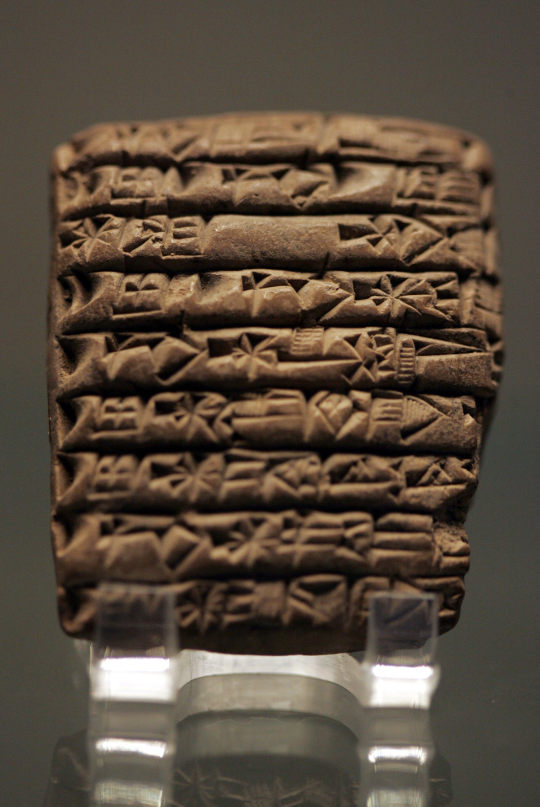
A typical Ur III administrative tablet listing offerings to various deities (wikimedia commons)
The first absolutely certain attestations of Nanaya, now firmly under her full name, have been identified in texts from the famous archive from Puzrish-Dagan, modern Drehem, dated to around 2100 BCE. Much can be written about this site, but here it will suffice to say that it was a center of the royal administration of the Third Dynasty of Ur ("Ur III") responsible for the distribution of sacrificial animals. Nanaya appears there in a rather unique context - she was one of the deities whose cults were patronized by queen Shulgi-simti, one of the wives of Shulgi, the successor of the dynasty’s founder Ur-Namma. We do not know much about Shulgi-simti as a person - she did not write any official inscriptions announcing her preferred foreign policy or letters to relatives or poetry or anything else that typically can be used to gain a glimpse into the personal lives of Mesopotamian royalty. We’re not really sure where she came from, though Eshnunna is often suggested as her hometown. We actually do not even know what her original name was, as it is assumed she only came to be known as Shulgi-simti after becoming a member of the royal family. Tonia Sharlach suggested that the absence of information about her personal life might indicate that she was a commoner, and that her marriage to Shulgi was not politically motivated The one sphere of Shulgi-simti’s life which we are incredibly familiar with are her religious ventures. She evidently had an eye for minor, foreign or otherwise unusual goddesses, such as Belet-Terraban or Nanaya. She apparently ran what Sharlach in her “biography” of her has characterized as a foundation. It was tasked with sponsoring various religious celebrations. Since Shulgi-simti seemingly had no estate to speak of, most of the relevant documents indicate she procured offerings from a variety of unexpected sources, including courtiers and other members of the royal family. The scale of her operations was tiny: while the more official religious organizations dealt with hundreds or thousands of sacrificial animals, up to fifty or even seventy thousand sheep and goats in the case of royal administration, the highest recorded number at her disposal seems to be eight oxen and fifty nine sheep. A further peculiarity of the “foundation” is that apparently there was a huge turnover rate among the officials tasked with maintaining it. It seems nobody really lasted there for much more than four years. There are two possible explanations: either Shulgi-simti was unusually difficult to work with, or the position was not considered particularly prestigious and was, at the absolute best, viewed as a stepping stone. While the Shulgi-simti texts are the earliest evidence for worship of Nanaya in the Ur III court, they are actually not isolated. When all the evidence from the reigns of Shulgi and his successors is summarized, it turns out that she quickly attained a prominent role, as she is among the twelve deities who received the most offerings. However, her worship was seemingly limited to Uruk (in her own sanctuary), Nippur (in the temple of Enlil, Ekur) and Ur. Granted, these were coincidentally three of the most important cities in the entire empire, so that’s a pretty solid early section of a divine resume. She chiefly appears in two types of ceremonies: these tied to the royal court, or these mostly performed by or for women. Notably, a festival involving lamentations (girrānum) was held in her honor in Uruk. To understand Nanaya’s presence in the two aforementioned contexts, and by extension her persistence in Mesopotamian religion in later periods, we need to first look into her character.
The character of Nanaya: eroticism, kingship, and disputed astral ventures

Corona Borealis (wikimedia commons)
Nanaya’s character is reasonably well defined in primary sources, but surprisingly she was almost entirely ignored in scholarship quite recently. The first study of her which holds up to scrutiny is probably Joan Goodnick Westenholz’s article Nanaya, Lady of Mystery from 1997. The core issue is the alleged interchangeability of goddesses. From the early days of Assyriology basically up to the 1980s, Nanaya was held to be basically fully interchangeable with Inanna. This obviously put her in a tough spot. Still, over the course of the past three decades the overwhelming majority of studies came to recognize Nanaya as a distinct goddess worthy of study in her own right. You will still stumble upon the occasional “Nanaya is basically Inanna”, but now this is a minority position. Tragically it’s not extinct yet, most recently I’ve seen it in a monograph published earlier this year. With these methodological and ideological issues out of the way, let’s actually look into Nanaya’s character, as promised by the title of this section. Her original role was that of a goddess of love. It is already attested for her at the dawn of her history, in the Ur III period. Her primary quality was described with a term rendered as ḫili in Sumerian and kuzbu in Akkadian. It can be variously translated as “charm”, “luxuriance”, “voluptuousness”, “sensuality” or “sexual attractiveness”. This characteristic was highlighted by her epithet bēlet kuzbi (“lady of kuzbu”) and by the name of her cella in the Eanna, Eḫilianna. The connection was so strong that this term appears basically in every single royal inscription praising her. She was also called bēlet râmi, “lady of love”. Nanaya’s role as a love goddess is often paired with describing her as a “joyful” or “charming” deity. It needs to be stressed that Nanaya was by no metric the goddess of some abstract, cosmic love or anything like that. Love incantations and prayers related to love are quite common, and give us a solid glimpse into this matter. Nanaya’s range of activity in them is defined pretty directly: she deals with relationships (and by extension also with matters like one-sided crushes or arguments between spouses), romance and with strictly sexual matters. For an example of a hymn highlighting her qualifications when it comes to the last category, see here. The text is explicit, obviously. We can go deeper, though. There is also an incantation whose incipit at first glance leaves little to imagination:

However, the translator, Giole Zisa, notes there is some debate over whether it’s actually about having sex with Nanaya or merely about invoking her (and other deities) while having sex with someone else. A distinct third possibility is that she’s not even properly invoked but that “oh, Nanaya” is simply an exclamation of excitement meant to fit the atmosphere, like a specialized version of the mainstay of modern erotica dialogue, “oh god”.
While this romantic and sexual aspect of Nanaya’s character is obviously impossible to overlook, this is not all there was to her. She was also associated with kingship, as already documented in the Ur III period. She was invoked during coronations and mourning of deceased kings. In the Old Babylonian period she was linked to investiture by rulers of newly independent Uruk. A topic which has stirred some controversy in scholarship is Nanaya’s supposed astral role. Modern authors who try to present Nanaya as a Venus deity fall back on rather faulty reasoning, namely asserting that if Nanaya was associated with Inanna and Inanna personified Venus, clearly Nanaya did too. Of course, being associated with Inanna does not guarantee the same traits. Shaushka was associated with her so closely her name was written with the logogram representing her counterpart quite often, and lacked astral aspects altogether. No primary sources which discuss Nanaya as a distinct, actively worshiped deity actually link her with Venus. If you stretch it you will find some tidbits like an entry in a dictionary prepared by the 10th century bishop Hasan bar Bahlul, who inexplicably asserted Nanaya was the Arabic name of the planet Venus. As you will see soon, there isn’t even a possibility that this reflected a relic of interpretatio graeca. The early Mandaean sources, many of which were written when at least remnants of ancient Mesopotamian religion were still extant, also do not link Nanaya with Venus. Despite at best ambivalent attitude towards Mesopotamian deities, they show remarkable attention to detail when it comes to listing their cult centers, and on top of that Mesopotamian astronomy had a considerable impact on Mandaeism, so there is no reason not to prioritize them, as far as I am concerned. As far as the ancient Mesopotamian sources themselves go, the only astral object with a direct connection to Nanaya was Corona Borealis (BAL.TÉŠ.A, “Dignity”), as attested in the astronomical compendium MUL.APIN. Note that this is a work which assigns astral counterparts to virtually any deity possible, though, and there is no indication this was a major part of Nanaya’s character. Save for this single instance, she is entirely absent from astronomical texts. A further astral possibility is that Nanaya was associated with the moon. The earliest evidence is highly ambiguous: in the Ur III period festivals held in her honor might have been tied to phases of the moon, while in the Old Babylonian period a sanctuary dedicated to her located in Larsa was known under the ceremonial name Eitida, “house of the month”. A poem in which looking at her is compared to looking at the moon is also known. That’s not all, though. Starting with the Old Babylonian period, she could also be compared with the sun. Possibly such comparisons were meant to present her as an astral deity, without necessarily identifying her with a specific astral body. Michael P. Streck and Nathan Wasserman suggest that it might be optimal to simply refer to her as a “luminous” deity in this context. However, as you will see later it nonetheless does seem she eventually came to be firmly associated both with the sun and the moon. Last but not least, Nanaya occasionally displayed warlike traits. It’s hardly major in her case, and if you tried hard enough you could turn any deity into a war deity depending on your political goals, though. I’d also place the incantation which casts her as one of the deities responsible for keeping the demon Lamashtu at bay here.
Nanaya in art

The oldest known depiction of Nanaya (wikimedia commons)
While Nanaya’s roles are pretty well defined, there surprisingly isn’t much to say about her iconography in Mesopotamian art.The oldest certain surviving depiction of her is rather indistinct: she’s wearing a tall headdress and a flounced robe. It dates to the late Kassite period (so roughly to 1200 BCE), and shows her alongside king Meli-Shipak (or maybe Meli-Shihu, reading remains uncertain) and his daughter Hunnubat-Nanaya. Nanaya is apparently invoked to guarantee that the prebend granted to the princess will be under divine protection. This is not really some unique prerogative of hers, perhaps she was just the most appropriate choice because Hunnubat-Nanaya’s name obviously reflects devotion to her. The relief discussed above is actually the only depiction of Nanaya identified with certainty from before the Hellenistic period, surprisingly. We know that statues representing her existed, and it is hard to imagine that a popular, commonly worshiped deity was not depicted on objects like terracotta decorations and cylinder seals, but even if some of these were discovered, there’s no way to identify them with certainty. This is not unusual though, and ultimately there aren’t many Mesopotamian deities who can be identified in art without any ambiguity.
Nanaya in literature
As I highlighted in the section dealing with Nanaya’s character, she is reasonably well attested in love poetry. However, this is not the only genre in which she played a role. A true testament to Nanaya’s prominence is a bilingual (Sumero-Akkadian) hymn composed in her honor in the first millennium BCE. It is written in the first person, and presents various other goddesses as her alternate identities. It is hardly unique, and similar compositions dedicated to Ishtar (Inanna), Gula, Ninurta and Marduk are also known. Each strophe describes a different deity and location, but ends with Nanaya reasserting her actual identity with the words “still I am Nanaya”. Among the claimed identities included are both major goddesses in their own right (Inanna plus closely associated Annunitum and Ishara, Gula, Bau, Ninlil), goddesses relevant due to their spousal roles first and foremost (Damkina, Shala, Mammitum etc) and some truly unexpected, picks, the notoriously elusive personified rainbow Manzat being the prime example. Most of them had very little in common with Nanaya, so this might be less an attempt at syncretism, and more an elevation of her position through comparisons to those of other goddesses. An additional possible literary curiosity is a poorly preserved myth which Wilfred G. Lambert referred to as “The murder of Anshar”. He argues that Nanaya is one of the two deities responsible for the eponymous act. I don't quite follow the logic, though: the goddess is actually named Ninamakalamma (“Lady mother of the land”), and her sole connection with Nanaya is that they occur in sequence in the unique god list from Sultantepe. Lambert saw this as a possible indication they are identical. There are no other attestations of this name, but ama kalamma does occur as an epithet of various goddesses, most notably Ninshubur. Given her juxtaposition with Nanaya in the Weidner god list - more on that later - wouldn’t it make more sense to assume it’s her? Due to obscurity of the text as far as I am aware nobody has questioned Lambert’s tentative proposal yet, though.
There isn’t much to say about the plot: Anshar, literally “whole heaven”, the father of Anu, presumably gets overthrown and might be subsequently killed. Something that needs to be stressed here to avoid misinterpretation: primordial deities such as Anshar were borderline irrelevant, and weren't really worshiped. They exist to fade away in myths and to be speculated about in elaborate lexical texts. There was no deposed cult of Anshar. Same goes for all the Tiamats and Enmesharras and so on.
Inanna and beyond: Nanaya and friends in Mesopotamian sources

Inanna on a cylinder seal from the second half of the third millennium BCE (wikimedia commons)
Of course, Nanaya’s single most important connection was that to Inanna, no matter if we are to accept the view that she was effectively a hypostasis gone rogue or not. The relationship between them could be represented in many different ways. Quite commonly she was understood as a courtier or protegee of Inanna. A hymn from the reign of Ishbi-Erra calls her the “ornament of Eanna” (Inanna’s main temple in Uruk) and states she was appointed by Inanna to her position. References to Inanna as Nanaya’s mother are also known, though they are rare, and might be metaphorical. To my best knowledge nothing changed since Olga Drewnowska-Rymarz’s monograph, in which she notes she only found three examples of texts preserving this tradition. I would personally abstain from trying to read too deep into it, given this scarcity. Other traditions regarding Nanaya’s parentage are better attested. In multiple cases, she “borrows” Inanna’s conventional genealogy, and as a result is addressed as a daughter of Sin (Nanna), the moon god. However, she was never addressed as Inanna’s sister: it seems that in cases where Sin and Nanaya are connected, she effectively “usurps” Inanna’s own status as his daughter (and as the sister of Shamash, while at it). Alternatively, she could be viewed as a daughter of Anu. Finally, there is a peculiar tradition which was the default in laments: in this case, Nanaya was described as a daughter of Urash. The name in this context does not refer to the wife of Anu, though. The deity meant is instead a small time farmer god from Dilbat. To my best knowledge no sources place Nanaya in the proximity of other members of Urash’s family, though some do specify she was his firstborn daughter. To my best knowledge Urash had at least two other children, Lagamal (“no mercy”, an underworld deity whose gender is a matter of debate) and Ipte-bitam (“he opened the house”, as you can probably guess a divine doorkeeper). Nanaya’s mother by extension would presumably be Urash’s wife Ninegal, the tutelary goddess of royal palaces. There is actually a ritual text listing these three together. In the Weidner god list Nanaya appears after Ninshubur. Sadly, I found no evidence for a direct association between these two. For what it’s worth, they did share a highly specific role, that of a deity responsible for ordering around lamma. This term referred to a class of minor deities who can be understood as analogous to “guardian angels” in contemporary Christianity, except places and even deities had their own lamma too, not just people. Lamma can also be understood at once as a class of distinct minor deities, as the given name of individual members of it, and as a title of major deities. In an inscription of Gudea the main members of the official pantheon are addressed as “lamma of all nations”, by far one of my favorite collective terms of deities in Mesopotamian literature. A second important aspect of the Weidner god list is placing Nanaya right in front of Bizilla. The two also appear side by side in some offering lists and in the astronomical compendium MUL.APIN, where they are curiously listed as members of the court of Enlil. It seems that like Nanaya, she was a goddess of love, which is presumably reflected by her name. It has been variously translated as “pleasing”, “loving” or as a derivative of the verb “to strip”. An argument can be made that Bizilla was to Nanaya what Nanaya was to Inanna. However, she also had a few roles of her own. Most notably, she was regarded as the sukkal of Ninlil. She may or may not also have had some sort of connection to Nungal, the goddess of prisons, though it remains a matter of debate if it’s really her or yet another, accidentally similarly named, goddess.
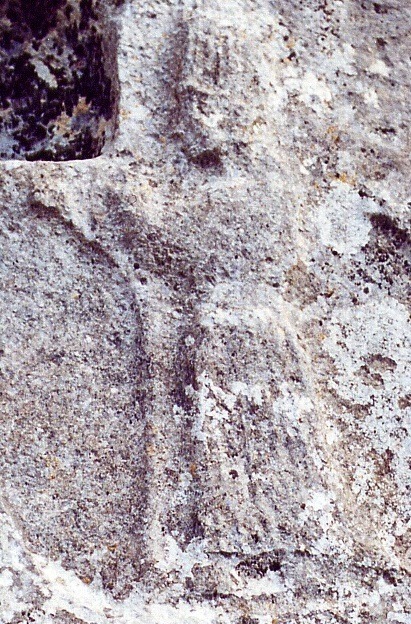
An indistinct Hurro-Hittite depiction of Ishara from the Yazilikaya sanctuary (wikimedia commons)
In love incantations, Nanaya belonged to an informal group which also included Inanna, Ishara, Kanisurra and Gazbaba. I do not think Inanna’s presence needs to be explained. Ishara had an independent connection with Inanna and was a multi-purpose deity to put it very lightly; in the realm of love she was particularly strongly connected with weddings and wedding nights. Kanisurra and Gazbaba warrant a bit more discussion, because they are arguably Nanaya’s supporting cast first and foremost. Gazbaba is, at the core, seemingly simply the personification of kuzbu. Her name had pretty inconsistent orthography, and variants such as Kazba or Gazbaya can be found in primary sources too. The last of them pretty clearly reflects an attempt at making her name resemble Nanaya’s. Not much can be said about her individual character beyond the fact she was doubtlessly related to love and/or sex. She is described as the “grinning one” in an incantation which might be a sexual allusion too, seeing as such expressions are a mainstay of Akkadian erotic poetry. Kanisurra would probably win the award for the fakest sounding Mesopotamian goddess, if such a competition existed. Her name most likely originated as a designation of the gate of the underworld, ganzer. Her default epithet was “lady of the witches” (bēlet kaššāpāti). And on top of that, like Nanaya and Gazbaba she was associated with sex. She certainly sounds more like a contemporary edgy oc of the Enoby Dimentia Raven Way variety than a bronze age goddess - and yet, she is completely genuine. It is commonly argued Kanisurra and Gazbaba were regarded as Nanaya’s daughters, but there is actually no direct evidence for this. In the only text where their relation to Nanaya is clearly defined they are described as her hairdressers, rather than children. While in some cases the love goddesses appear in love incantations in company of each other almost as if they were some sort of disastrous polycule, occasionally Nanaya is accompanied in them by an anonymous spouse. Together they occur in parallel with Inanna and Dumuzi and Ishara and Almanu, apparently a (accidental?) deification of a term referring to someone without family obligations. There is only one Old Babylonian source which actually assigns a specific identity to Nanaya’s spouse, a hymn dedicated to king Abi-eshuh of Babylon. An otherwise largely unknown god Muati (I patched up his wiki article just for the sake of this blog post) plays this role here. The text presents a curious case of reversal of gender roles: Muati is asked to intercede with Nanaya on behalf of petitioners. Usually this was the role of the wife - the best known case is Aya, the wife of Shamash, who is implored to do just that by Ninsun in the standard edition of the Epic of Gilgamesh. It’s also attested for goddesses such as Laz, Shala, Ninegal or Ninmug… and in the case of Inanna, for Ninshubur.
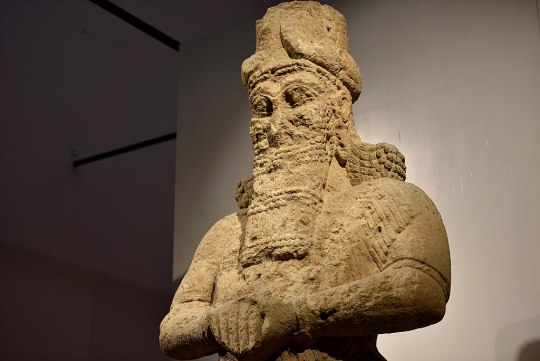
A Neo-Assyrian statue of Nabu on display in the Iraq Museum (wikimedia commons)
Marten Stol seems to treat Muati and Nabu as virtually the same deity, and on this basis states that Nanaya was already associated with the latter in the Old Babylonian period, but this seems to be a minority position. Other authors pretty consistently assume that Muati was a distinct deity at some point “absorbed” by Nabu. The oldest example of pairing Nanaya with Nabu I am aware of is an inscription dated to the reign of Marduk-apla-iddina I, so roughly to the first half of the twelfth century BCE. The rise of this tradition in the first millennium BCE was less theological and more political. With Babylon once again emerging as a preeminent power, local theologies were supposed to be subordinated to the one followed in the dominant city. Which, at the time, was focused on Nabu, Marduk and Zarpanit. Worth noting that Nabu also had a spouse before, Tashmetum (“reconciliation”). In the long run she was more or less ousted by Nanaya from some locations, though she retained popularity in the north, in Assyria. She is not exactly the most thrilling deity to discuss. I will confess I do not find the developments tied to Nanaya and Nabu to be particularly interesting to cover, but in the long run they might have resulted in Nanaya acquiring probably the single most interesting “supporting cast member” she did not share with Inanna, so we’ll come back to this later. Save for Bizilla, Nanaya generally was not provided with “equivalents” in god lists. I am only aware of one exception, and it’s a very recent discovery. Last year the first ever Akkadian-Amorite bilingual lists were published. This is obviously a breakthrough discovery, as before Amorite was largely known just from personal names despite being a vernacular language over much of the region in the bronze age, but only one line is ultimately of note here. In a section of one of the lists dealing with deities, Nanaya’s Amorite counterpart is said to be Pidray. This goddess is otherwise almost exclusively known from Ugarit. This of course fits very well with the new evidence: recent research generally stresses that Ugarit was quintessentially an Amorite city (the ruling house even claimed descent from mythical Ditanu, who is best known from the grandiose fictional genealogies of Shamshi-Adad I and the First Dynasty of Babylon). Sadly, we do not know how the inhabitants of Ugarit viewed Nanaya. A trilingual version of the Weidner list, with the original version furnished with columns listing Ugaritic and Hurrian counterparts of each deity, was in circulation, but the available copies are too heavily damaged to restore it fully. And to make things worse, much of it seems to boil down to scribal wordplay and there is no guarantee all of the correspondences are motivated theologically. For instance, the minor Mesopotamian goddess Imzuanna is presented as the counterpart of Ugaritic weather god Baal because her name contains a sign used as a shortened logographic writing of the latter. An even funnier case is the awkward attempt at making it clear the Ugaritic sun deity Shapash, who was female, is not a lesbian… by making Aya male. Just astonishing, really.
The worship of Nanaya
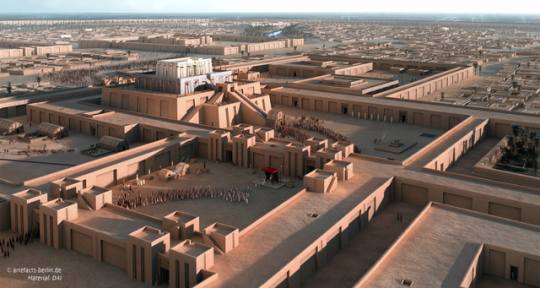
A speculative reconstruction of Ur III Uruk with the Eanna temple visible in the center (Artefacts — Scientific Illustration & Archaeological Reconstruction; reproduced here for educational purposes only, as permitted)
Rather fittingly, as a deity associated with Inanna, Nanaya was worshiped chiefly in Uruk. She is also reasonably well attested in the inscriptions of the short-lived local dynasty which regained independence near the end of the period of domination of Larsa over Lower Mesopotamia. A priest named after her, a certain Iddin-Nanaya, for a time served as the administrator of her temple, the Enmeurur, “house which gathers all the me,” me being a difficult to translate term, something like “divine powers”. The acquisition of new me is a common topic in Mesopotamian literature, and in compositions focused on Inanna in particular, so it should not be surprising to anyone that her peculiar double seemingly had similar interests. In addition to Uruk, as well as Nippur and Ur, after the Ur III period Nanaya spread to multiple other cities, including Isin, Mari, Babylon and Kish. However, she is probably by far the best attested in Larsa, where she rose to the rank of one of the main deities, next to Utu, Inanna, Ishkur and Nergal. She had her own temple, the Eshahulla, “house of a happy heart”. In local tradition Inanna got to keep her role as an “universal” major goddess and her military prerogatives, but Nanaya overtook the role of a goddess of love almost fully. Inanna’s astral aspect was also locally downplayed, since Venus was instead represented in the local pantheon by closely associated, but firmly distinct, Ninsianna. This deity warrants some more discussion in the future just due to having a solid claim to being one of the first genderfluid literary figures in history, but due to space constraints this cannot be covered in detail here. A later inscription from the same city differentiates between Nanaya and Inanna by giving them different epithets: Nanaya is the “queen of Uruk and Eanna” (effectively usurping Nanaya’s role) while Inanna is the “queen of Nippur” (that’s actually a well documented hypostasis of her, not to be confused with the unrelated “lady of Nippur”). Uruk was temporarily abandoned in the late Old Babylonian period, but that did not end Nanaya’s career. Like Inanna, she came to be temporarily relocated to Kish. It has been suggested that a reference to her residence in “Kiššina” in a Hurro-Hittite literary text, the Tale of Appu, reflects her temporary stay there. The next centuries of Nanaya are difficult to reconstruct due to scarce evidence, but it is clear she continued to be worshiped in Uruk. By the Neo-Babylonian period she was recognized as a member of an informal pentad of the main deities of the city, next to Inanna, Urkayitu, Usur-amassu and Beltu-sa-Resh. Two of them warrant no further discussion: Urkayitu was most likely a personification of the city, and Beltu-sa-Resh despite her position is still a mystery to researchers. Usur-amassu, on the contrary, is herself a fascinating topic. First attestations of this deity, who was seemingly associated with law and justice (a pretty standard concern), come back to the Old Babylonian period. At this point, Usur-amassu was clearly male, which is reflected by the name. He appears in the god list An = Anum as a son of the weather deity couple par excellence, Adad (Ishkur) and Shala. However, by the early first millennium BCE Usur-amassu instead came to be regarded as female - without losing the connection to her parents. She did however gain a connection to Inanna, Nanaya and Kanisurra, which she lacked earlier. How come remains unknown. Most curiously her name was not modified to reflect her new gender, though she could be provided with a determinative indicating it. This recalls the case of Lagamal in the kingdom of Mari some 800 years earlier.
The end of the beginning: Nanaya under Achaemenids and Seleucids
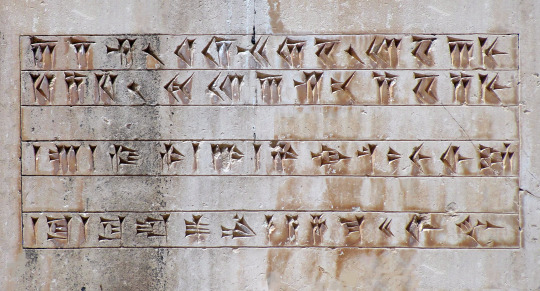
Trilingual (Persian, Elamite and Akkadian) inscription of the first Achamenid ruler of Mesopotamia, Cyrus (wikimedia commons)
After the fall of the Neo-Babylonian Empire Mesopotamia ended up under Achaemenid control, which in turn was replaced by the Seleucids. Nanaya flourished through both of these periods. In particular, she attained considerable popularity among Arameans. While they almost definitely first encountered her in Uruk, she quickly came to be venerated by them in many distant locations, like Palmyra, Hatra and Dura Europos in Syria. She even appears in a single Achaemenid Aramaic papyrus discovered in Elephantine in Egypt. It indicates that she was worshiped there by a community which originated in Rash, an area east to the Tigris. As a curiosity it’s worth mentioning the same source is one of the only attestations of Pidray from outside Ugarit. I do not think this has anything to do with the recently discovered connection between her and Nanaya… but you may never know. Under the Seleucids, Nanaya went through a particularly puzzling process of partial syncretism. Through interpretatio graeca she was identified with… Artemis. How did this work? The key to understanding this is the fact Seleucids actually had a somewhat limited interest in local deities. All that was necessary was to find relatively major members of the local pantheon who could roughly correspond to the tutelary deities of their dynasty: Zeus, Apollo and Artemis. Zeus found an obvious counterpart in Marduk (even though Marduk was hardly a weather god). Since Nabu was Marduk’s son, he got to be Apollo. And since Nanaya was the most major goddess connected to Nabu, she got to be Artemis. It really doesn’t go deeper than that. For what it’s worth, despite the clear difference in character this newfound association did impact Nanaya in at least one way: she started to be depicted with attributes borrowed from Artemis, namely a bow and a crescent. Or perhaps these attributes were already associated with her, but came to the forefront because of the new role. The Artemis-like image of Nanaya as an archer is attested on coins, especially in Susa, yet another city where she attained considerable popularity.
Leaving Mesopotamia: Nanaya and the death of cuneiform
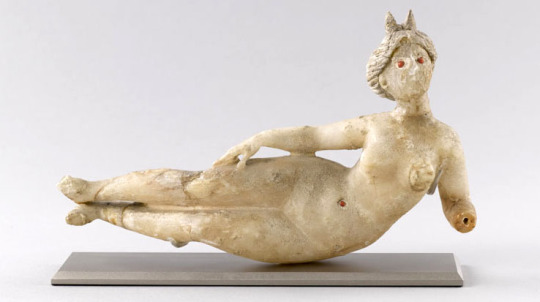
A Parthian statue of Nanaya with a crescent diadem (Louvre; reproduced here for educational purposes only. Identification follows Andrea Sinclair's proposal)
The Seleucid dynasty was eventually replaced by the Parthians. This period is often considered a symbolic end of ancient Mesopotamian religion in the strict sense. Traditional religious institutions were already slowly collapsing in Achaemenid and Seleucid times as the new dynasties had limited interest in royal patronage. Additionally, cuneiform fell out of use, and by the end of the first half of the first millennium CE the art of reading and writing it was entirely lost. This process did not happen equally quickly everywhere, obviously, and some deities fared better than others in the transitional period before the rise of Christianity and Islam as the dominant religions across the region. Nanaya was definitely one of them, at least for a time. In Parthian art Nanaya might have developed a distinct iconography: it has been argued she was portrayed as a nude figure wearing only some jewelry (including what appears to be a navel piercing and a diadem with a crescent. The best known example is probably this standing figure, one of my all time favorite works of Mesopotamian art:

Parthian Nanaya (wikimedia commons; identification courtesy of the Louvre website and J. G. Westenholz)
For years Wikipedia had this statue mislabeled as “Astarte” which makes little sense considering it comes from a necropolis near Babylon. There was also a viral horny tweet which labeled it as “Asherah” a few months ago (I won’t link it but I will point out in addition to getting the name wrong op also severely underestimated the size). This is obviously even worse nonsense both on spatial and temporal grounds. Even if the biblical Asherah was ever an actual deity like Ugaritic Athirat and Mesopotamian Ashratum, it is highly dubious she would still be worshiped by the time this statue was made. It’s not even certain she ever was a deity, though. Cognate of a theonym is not automatically a theonym itself, and the Ugaritic texts and the Bible, even if they share some topoi, are separated by centuries and a considerable distance. This is not an Asherah post though, so if this is a topic which interests you I recommend downloading Steve A. Wiggins’ excellent monograph A Reassessment of Asherah: With Further Considerations of the Goddess.
The last evidence for the worship of Nanaya in Mesopotamia is a Mandaean spell from Nippur, dated to the fifth or sixth century CE. However, at this point Nanaya must have been a very faint memory around these parts, since the figure designated by this name is evidently male in this formula. That was not the end of her career, though. The system of beliefs she originated and thrived in was on its way out, but there were new frontiers to explore. A small disgression is in order here: be INCREDIBLY wary of claims about the survival of Mesopotamian tradition in Mesopotamia itself past the early middle ages. Most if not all of these come from the writing of Simo Parpola, who is a 19th century style hyperdiffusionist driven by personal religious beliefs based on gnostic christianity, which he believes was based on Neo-Assyrian state religion, which he misinterprets as monotheism, or rather proto-christianity specifically (I wish I was making this up). I personally do not think a person like that should be tolerated in serious academia, but for some incomprehensible reason that isn’t the case.
New frontiers: Nanaya in Bactria
The key to Nanaya’s extraordinarily long survival wasn’t the dedication to her in Mesopotamia, surprisingly. It was instead her introduction to Bactria, a historical area in Central Asia roughly corresponding to parts of modern Afghanistan, Tajikistan and Uzbekistan. The early history of this area is still poorly known, though it is known that it was one of the “cradles of civilization” not unlike Mesopotamia, the Indus Valley or Mesoamerica. The so-called “Oxus civilization” or “Bactria-Margiana Archaeological Complex” flourished around 2500-1950 BCE (so roughly contemporarily with the Akkadian and Ur III empires in Mesopotamia). It left behind no written records, but their art and architecture are highly distinctive and reflect great social complexity. I sadly can’t spent much time discussing them here though, as they are completely irrelevant to the history of Nanaya (there is a theory that she was already introduced to the east when BMAC was extant but it is incredibly implausible), so I will limit myself to showing you my favorite related work of art, the “Bactrian princess”:
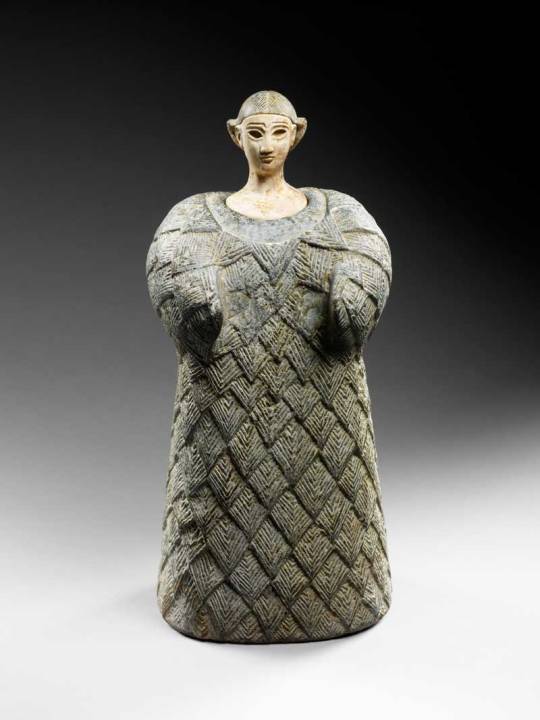
Photo courtesy of Louvre Abu Dhabi, reproduced here for educational purposes only.
By late antiquity, which is the period we are concerned with here, BMAC was long gone, and most of the inhabitants of Bactria spoke Bactrian, an extinct Iranian language. How exactly they were related to their BMAC forerunners is uncertain. Their religious beliefs can be compared to Zoroastrianism, or rather with its less formalized forerunners followed by most speakers of Iranian languages before the rise of Zoroaster. However, there were many local peculiarities. For example, the main deity was the personified river Oxus, not Ahura Mazda. Whether this was a relic of BMAC religion is impossible to tell.We do not know exactly when the eastward transfer of Nanaya to Bactria happened. The first clear evidence for her presence in central Asia comes from the late first century BCE, from the coins of local rulers, Sapadbizes and Agesiles. It is possible that her depictions on coinage of Mesopotamian and Persian rulers facilitated her spread. Of course, it’s also important to remember that the Aramaic script and language spread far to the east in the Achaemenid period already, and that many of the now extinct Central Asian scripts were derived from it (Bactrian was written with the Greek script, though). Doubtlessly many now lost Aramaic texts were transferred to the east. There’s an emerging view that for unclear reasons, under the Achaemenids Mesopotamian culture as a whole had unparalleled impact on Bactria. The key piece of evidence are Bactrian temples, which often resemble Mesopotamian ones. Therefore, perhaps we should be wondering not why Nanaya spread from Mesopotamia to Central Asia, but rather why there were no other deities who did, for the most part. That is sadly a question I cannot answer. Something about Nanaya simply made her uniquely appealing to many groups at once. While much about the early history of Nanaya in Central Asia is a mystery, it is evident that with time she ceased to be viewed as a foreign deity. For the inhabitants of Bactria she wasn’t any less “authentically Iranian” than the personified Oxus or their versions of the conventional yazatas like Sraosha. Frequently arguments are made that Nanaya’s widespread adoption and popularity could only be the result of identification between her and another deity.Anahita in particular is commonly held to be a candidate. However, as stressed by recent studies there’s actually no evidence for this. What is true is that Anahita is notably missing from the eastern Iranian sources, despite being prominent in the west from the reign of the Achaemenid emperor Artaxerxes II onward. However, it is clear that not all yazatas were equally popular in each area - pantheons will inevitably be localized in each culture. Furthermore, Anahita’s character has very little in common with Nanaya save for gender. Whether we are discussing her early not quite Zoroastrian form the Achaemenid public was familiar with or the contemporary yazata still relevant in modern Zoroastrianism, the connection to water is the most important feature of her. Nanaya didn’t have such a role in any culture. Recently some authors suggested a much more obvious explanation for Anahita’s absence from the eastern Iranian pantheon(s). As I said, eastern Iranian communities venerated the river Oxus as a deity (or as a yazata, if you will). He was the water god par excellence, and in Bactria also the king of the gods. It is therefore quite possible that Anahita, despite royal backing from the west, simply couldn’t compete with him. Their roles overlapped more than the roles of Anahita and Nanaya. I am repeating myself but the notion of interchangeability of goddesses really needs to be distrusted almost automatically, no matter how entrenched it wouldn’t be. While we’re at it, the notion of alleged interchangeability between Anahita and Ishtar is also highly dubious, but that’s a topic for another time.
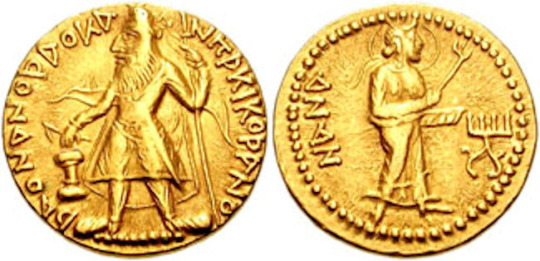
Nana (Nanaya) on a coin of Kanishka (wikimedia commons)
Nanaya experienced a period of almost unparalleled prosperity with the rise of the Kushan dynasty in Bactria. The Kushans were one of the groups which following Chinese sources are referred to as Yuezhi. They probably did not speak any Iranian language originally, and their origin is a matter of debate. However, they came to rule over a kingdom which consisted largely of areas inhabited by speakers of various Iranian languages, chiefly Bactrian. Their pantheon, documented in royal inscriptions and on coinage, was an eerie combination of mainstays of Iranian beliefs like Sraosha and Mithra and some unique figures, like Oesho, who was seemingly the reflection of Hindu Shiva. Obviously, Nanaya was there too, typically under the shortened name Nana. The most famous Kushan ruler, emperor Kanishka, in his inscription from Rabatak states that kingship was bestowed upon him by “Nana and all the gods”. However, we do not know if the rank assigned to her indicates she was the head of the dynastic pantheon, the local pantheon in the surrounding area, or if she was just the favorite deity of Kanishka. Same goes for the rank of numerous other deities mentioned in the rest of the inscription. Her apparent popularity during Kanishka’s reign and beyond indicates her role should not be downplayed, though. The coins of Kanishka and other Bactrian art indicate that a new image of Nanaya developed in Central Asia. The Artemis-like portrayals typical for Hellenistic times continue to appear, but she also started to be depicted on the back of a lion. There is only one possible example of such an image from the west, a fragmentary relief from Susa, and it’s roughly contemporary with the depictions from Bactria. While it is not impossible Nanaya originally adopted the lion association from one of her Mesopotamian peers, it is not certain how exactly this specific type of depictions originally developed, and there is a case to be made that it owed more to the Hellenistic diffusion of iconography of deities such as Cybele and Dionysus, who were often depicted riding on the back of large felines. The lunar symbols are well attested in the Kushan art of Nanaya too. Most commonly, she’s depicted wearing a diadem with a crescent. However, in a single case the symbol is placed behind her back. This is an iconographic type which was mostly associated with Selene at first, but in the east it was adopted for Mah, the Iranian personification of the moon. I’d hazard a guess that’s where Nanaya borrowed it from - more on that later. The worship of Nanaya survived the fall of the Kushan dynasty, and might have continued in Bactria as late as in the eighth century. However, the evidence is relatively scarce, especially compared with yet another area where she was introduced in the meanwhile.
Nanaya in Sogdia: new home and new friends
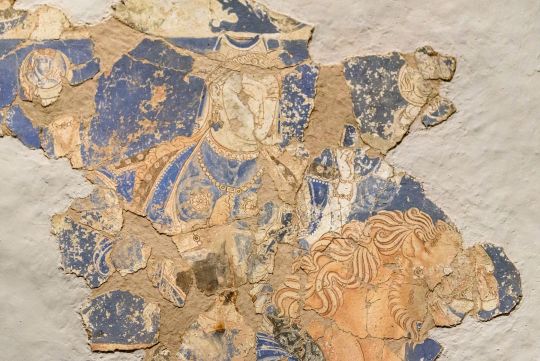
A Sogdian depiction of Nanaya from Bunjikat (wikimedia commons)
Presumably from Bactria, Nanaya was eventually introduced to Sogdia, its northern neighbor. I think it’s safe to say this area effectively became her new home for the rest of her history. Like Bactrians, the Sogdians also spoke an eastern Iranian language, Sogdian. It has a direct modern descendant, Yaghnobi, spoken by a small minority in Tajikistan. The religions Sogdians adhered to is often described as a form of Zoroastrianism, especially in older sources, but it would appear that Ahura Mazda was not exactly the most popular deity. Their pantheon was seemingly actually headed by Nanaya. Or, at the very least, the version of it typical for Samarkand and Panijkant, since there’s a solid case to be made for local variety in the individual city-states which made up Sogdia. It seems that much like Mesopotamians and Greeks centuries before them, Sogdians associated specific deities with specific cities, and not every settlement necessarily venerated each deity equally (or at all). Nanaya's remarkable popularity is reflected by the fact the name Nanaivandak, "servant of Nanaya", is one of the most common Sogdian names in general. It is agreed that among the Sogdians Panjikant was regarded as Nanaya’s cult center. She was referred to as “lady” of this city. At one point, her temple located there was responsible for minting the local currency. By the eighth century, coins minted there were adorned with dedications to her - something unparalleled in Sogdian culture, as the rest of coinage was firmly secular. This might have been an attempt at reasserting Sogdian religious identity in the wake of the arrival of Islam in Central Asia. Sogdians adopted the Kushan iconography of Nanaya, though only the lion-mounted version. The connection between her and this animal was incredibly strong in Sogdian art, with no other deity being portrayed on a similar mount. There were also innovations - Nanaya came to be frequently portrayed with four arms. This reflects the spread of Buddhism through central Asia, which brought new artistic conventions from India. While the crescent symbol can still be found on her headwear, she was also portrayed holding representations of the moon and the sun in two of her hands. Sometimes the solar disc and lunar orb are decorated with faces, which has been argued to be evidence that Nanaya effectively took over the domains of Mah and Mithra, who would be the expected divine identities of these two astral bodies. She might have been understood as controlling the passage of night and day. It has also been pointed out that this new iconographic type is the natural end point of the evolution of her astral role. Curiously, while no such a function is attested for Nanaya in Bactria, in Sogdia she could be sometimes regarded as a warlike deity. This is presumably reflected in a painting showing her and an unidentified charioteer fighting demons.
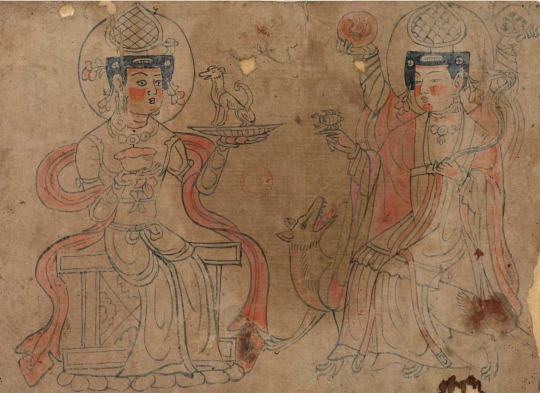
The "Sogdian Deities" painting from Dunhuang, a possible depiction of Nanaya and her presumed spouse Tish (wikimedia commons)
Probably the most fascinating development regarding Nanaya in Sogdia was the development of an apparent connection between her and Tish. This deity was the Sogdian counterpart of one of the best known Zoroastrian yazatas, Tishtrya, the personification of Sirius. As described in the Tištar Yašt, the latter is a rainmaking figure and a warlike protector who keeps various nefarious forces, such as Apaosha, Duzyariya and the malign “worm stars” (comets), at bay. Presumably his Sogdian counterpart had a similar role. While this is not absolutely certain, it is generally agreed that Nanaya and Tish were regarded as a couple in central Asia (there’s a minority position she was instead linked with Oesho, though). Most likely the fact that in Achaemenid Persia Tishtrya was linked with Nabu (and by extension with scribal arts) has something to do with this. There is a twist to this, though. While both Nabu and the Avestan Tishtrya are consistently male, in Bactria and Sogdia the corresponding deity’s gender actually shows a degree of ambiguity. On a unique coin of Kanishka, Tish is already portrayed as a feminine figure distinctly similar to Greek Artemis - an iconographic type which normally would be recycled for Nanaya. There’s also a possibility that a feminine, or at least crossdressing, version of Tish is portrayed alongside Nanaya on a painting from Dunhuang conventionally referred to as “Sogdian Daēnās” or “Sogdian Deities”, but this remains uncertain. If this identification is correct, it indicates outright interchange of attributes between them and Nanaya was possible.
The final frontier: Nanaya and the Sogdian diaspora in China Sogdians also brought Nanaya with them to China, where many of them settled in the Six Dynasties and Tang periods. An obviously Sinicized version of her, accompanied by two attendants of unknown identity, is portrayed on a Sogdian funerary couch presently displayed in the Miho Museum.
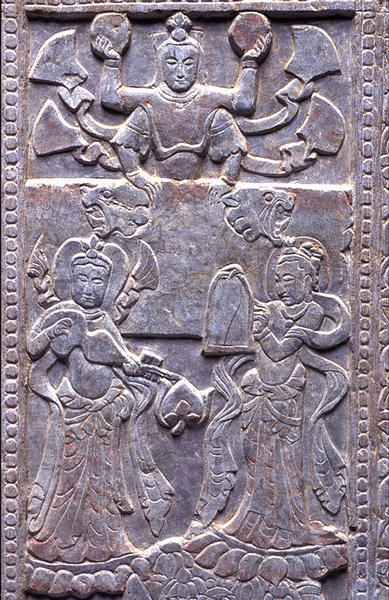
Nanaya (top) on a relief from the Miho funerary couch (Miho Museum; reproduced here for educational purposes only)
For the most part the evidence is limited to theophoric names, though. Due to unfamiliarity with Sogdian religious traditions and phonetic differences between the languages there was no consistent Chinese transcription of Nanaya’s name. I have no clue if Chinese contemporaries of the Sogdians were always aware of these elements in personal names referred to a deity. There is a fringe theory that Nanaya was referred to as Nantaihou (那那女主, “queen Nana”) in Chinese. However, the evidence is apparently not compelling, and as I understand the theory depends in no small part on the assertion that a hitherto unattested alternate reading of one of the signs was in use on the western frontiers of China in the early first millennium CE. The alleged Nantaihou is therefore most likely a misreading of a reference to a deceased unnamed empress dowager venerated through conventional ancestor worship, as opposed to Nanaya. Among members of the Sogdian diaspora, in terms of popularity Nanaya was going head to head with Jesus and Buddha. The presence of the latter two reflected the adoption of, respectively, Manichaeism and Buddhism. Manicheans seemingly were not fond of Nanaya, though, and fragments of a polemic against her cult have been identified. It seems ceremonies focused on lamentations were the main issue for the Manichaeans. Sadly there doesn’t seem to be any worthwhile study of possible Mesopotamian influence on that - the only one I found is old and confuses Nanaya with Inanna. We do not have much of an idea how Buddhists viewed Nanaya, though it is worth noting a number of other Sogdian deities were incorporated into the local form of Mahayana (unexpectedly, one of them was Zurvan). It has also been argued that a Buddhist figure, Vreshman (Vaisravana) was incorporated into Nanaya’s entourage. Nanaya might additionally be depicted in a painting showing Buddha’s triumph over Mara from Dunhuang. Presumably her inclusion would reflect the well attested motif of local deities converting to Buddhism. It was a part of the Buddhist repertoire from the early days of this religion and can be found in virtually every area where this religion ever spread. Nanaya is once again in elevated company here, since other figures near her have been tentatively interpreted as Shiva, Vishnu, Kartikeya and… Zoroaster.

Buddha conquering Mara (maravijaya) on a painting from Dunhuang (wikimedia commons)

zoom in on a possible depiction of Nanaya next to a demon suspiciously similar to Tove Jansson’s Fillyjonk
To my best knowledge, the last absolutely certain attestation of Nanaya as an actively worshiped deity also comes from the western frontier of China. A painting from Dandan Oilik belonging to the artistic tradition of the kingdom of Khotan shows three deities from the Sogdian pantheon: the enigmatic Āδβāγ (“highest god”; interpreted as either Indra, Ahura Mazda or a combination of them both) on the left, Weshparkar (a later version of Kushan Oesho) on the right and Nanaya in the center. It dates to the ninth or tenth century.
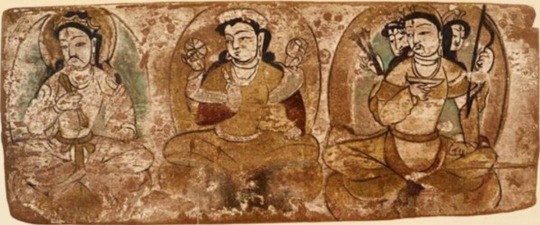
Nanaya (center) on the Dandan Oilik painting (wikimedia commons)
We will probably never know what Nanaya’s last days were like, though it is hard to imagine she retained much relevance with the gradual disappearance of Sogdian culture both in Sogdia and in China in the wake of, respectively, the rise of Islam in Central Asia and the An Lushan rebellion respectively. Her history ultimately most likely ended with a whimper rather than a bang. Conclusions and reflections Obviously, not everything about Nanaya could be covered in this article - there is enough material to warrant not one, but two wiki articles (and I don't even think they are extensive enough yet). I hope I did nonetheless manage to convey what matters: she was the single most enduring Mesopotamian deity who continued to be actually worshiped. She somehow outlived Enlil, Marduk, Nergal and even Inanna, and spread further than any of them ever did. It does not seem like her persistence was caused by some uniquely transcendent quality, and more to a mix of factors we will never really fully understand and pure luck. She is a far cry from the imaginary everlasting universal goddesses such longevity was attributed to by many highly questionable authors in the past, from Frazer to Gimbutas. Quite the opposite, once you look into the texts focused on her she comes across as sort of pathetic. After all, most of them are effectively ancient purple prose. And yet, this is precisely why I think Nanaya matters. To see how an author approaches her is basically a litmus test of trustworthiness - I wish I was kidding but this “Nanaya method” works every time. To even be able to study her history, let alone understand it properly, one has to cast away most of the dreadful trends which often hindered scholarship of ancient deities, and goddesses in particular, in the past. The interchangeability of goddesses; the Victorian mores and resulting notion that eroticism must be tied to fertility; the weird paradigms about languages neatly corresponding to religions; and many others. And if nothing else, this warrants keeping the memory of her 3000 years long history alive through scholarship (and, perhaps, some media appearances). Bibliography
Julia M. Asher-Greve & Joan Goodnick Westenholz, Goddesses in Context: On Divine Powers, Roles, Relationships and Gender in Mesopotamian Textual and Visual Sources (2013)
Paul-Alain Beaulieu, The Pantheon of Uruk During the Neo-Babylonian Period (2003)
idem, Nabû and Apollo: The Two Faces of Seleucid Religious Policy in: Orient und Okzident in Hellenistischer Zeit (2014)
Matteo Compareti, Nana and Tish in Sogdiana (2017)
idem, The So-Called "Pelliot Chinois 4518.24". Illustrated Document from Dunhuang and Sino-Sogdian Iconographical Contacts (2021)
Olga Drewnowska-Rymarz, Mesopotamian Goddess Nanāja (2008)
Benjamin R. Foster, Before the Muses: an Anthology of Akkadian Literature (2005)
Andrew R. George & Manfred Krebernik, Two Remarkable Vocabularies: Amorite-Akkadian Bilinguals! (2022)
Valerie Hansen, Kageyama Etsuko & Yutaka Yoshida, The Impact of the Silk Road Trade on a Local Community: The Turfan Oasis, 500-800 in: Les sogdiens en Chine (2005)
Wilfred G. Lambert, Babylonian Creation Myths (2013)
Enrico Marcato, An Aramaic Incantation Bowl and the Fall of Hatra (2020)
Christa Müller-Kessler & Karlheinz Kessler, Spätbabylonische Gottheiten in spätantiken mandäischen Texten (1999)
Lilla Russel-Smith, Uygur Patronage in Dunhuang. Regional Art Centres on the Northern Silk Road in the Tenth and Eleventh Centuries (2005)
idem, The 'Sogdian Deities' Twenty Years on: A Reconsideration of a Small Painting from Dunhuang in: Buddhism in Central Asia II. Practices and Rituals, Visual and Material Transfer (2022)
Tonia M. Sharlach, An Ox of One's Own. Royal Wives and Religion at the Court of the Third Dynasty of Ur (2017)
Michael Shenkar, Intangible Spirits and Graven Images: The Iconography of Deities in the Pre-Islamic Iranian World (2014)
idem, The Religion and the Pantheon of the Sogdians (5th-8th Centuries CE) in Light of their Sociopolitical Structures (2017)
idem, The So-Called "Fravašis" and the "Heaven and Hell" Paintings, and the Cult of Nana in Panjikent (2022)
Marten Stol, Nanaja in: Reallexikon der Assyriologie, vol. 9 (1998)
Michael P. Streck & Nathan Wasserman, More Light on Nanāya (2013)
Aaron Tugendhaft, Gods on Clay: Ancient Near Eastern Scholarly Practices and the History of Religions in: Canonical Texts and Scholarly Practices. A Global Comparative Approach (2016)
Joan Goodnick Westenholz, Nanaya, Lady of Mystery in: Sumerian Gods and Their Representations (1997)
idem, Trading the Symbols of the Goddess Nanaya in: Religions and Trade. Religious Formation, Transformation and Cross-Cultural Exchange between East and West (2014)
Xinjiang Rong, The Colophon of the Manuscript of the Golden Light Sutra Excavated in Turfan and the Transmission of Zoroastrianism to Gaochang in: The Silk Road and Cultural Exchanges between East and West (2022)
Gioele Zisa, The Loss of Male Sexual Desire in Ancient Mesopotamia. ›Nīš Libbi‹ Therapies (2021)
#mesopotamian mythology#sumerian mythology#mythology#bactrian mythology#sogdian mythology#sogdia#nanaya
478 notes
·
View notes
Text
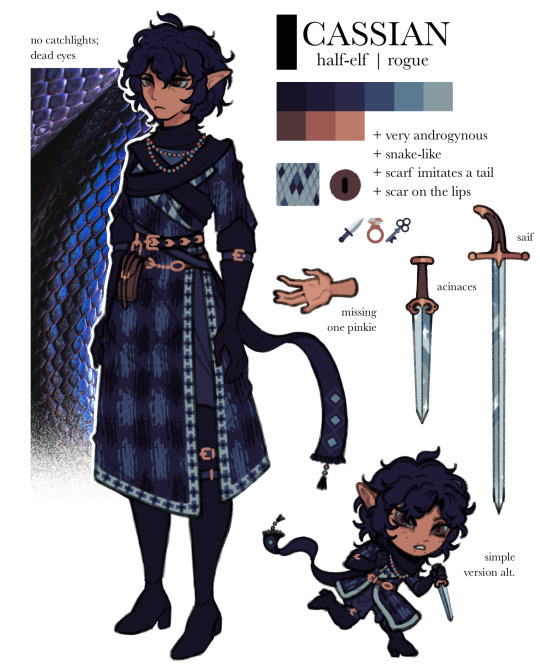
added a bunch of extra stuff to their ref so here’s a reupload 👍 look at my daughter
#art#oc#original character#percy oc: cassian#dnd#dnd character#dungeons and dragons#tav#bg3 tav#half elf#rogue#lesbian#fun fact in irl BC au they are half scythian half sogdian#in fantasy canon its coded as such
25 notes
·
View notes
Text
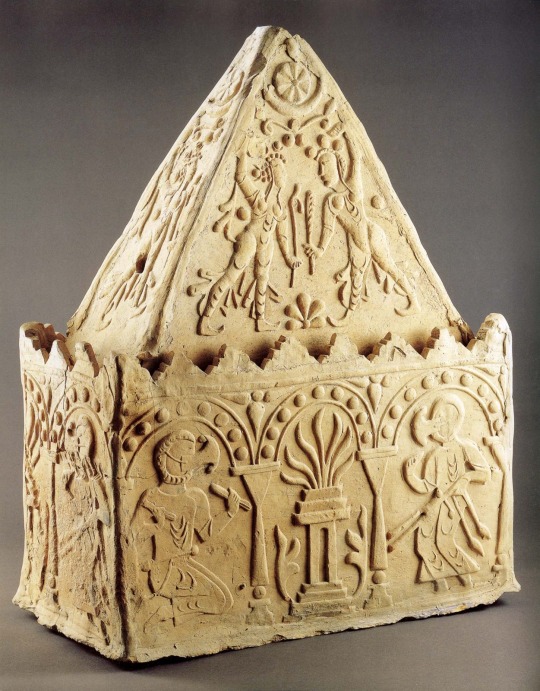
Look at this beautiful ossuary.
#history#ancient history#zoroastrianism#ancient iran#ancient persia#sasanian empire#sassanian empire#zoroastrian priests#sogdian#fire temple
49 notes
·
View notes
Text
Origins of the Pibo: Let’s take a trip along the Silk Road.
1. Introduction to the garment:
Pibo 披帛 refers to a very thin and long shawl worn by women in ancient East Asia approximately between the 5th to 13th centuries CE. Pibo is a modern name and its historical counterpart was pei 帔. But I’ll use pibo as to not confuse it with Ming dynasty’s xiapei 霞帔 and a much shorter shawl worn in ancient times also called pei.
Below is a ceramic representation of the popular pibo.
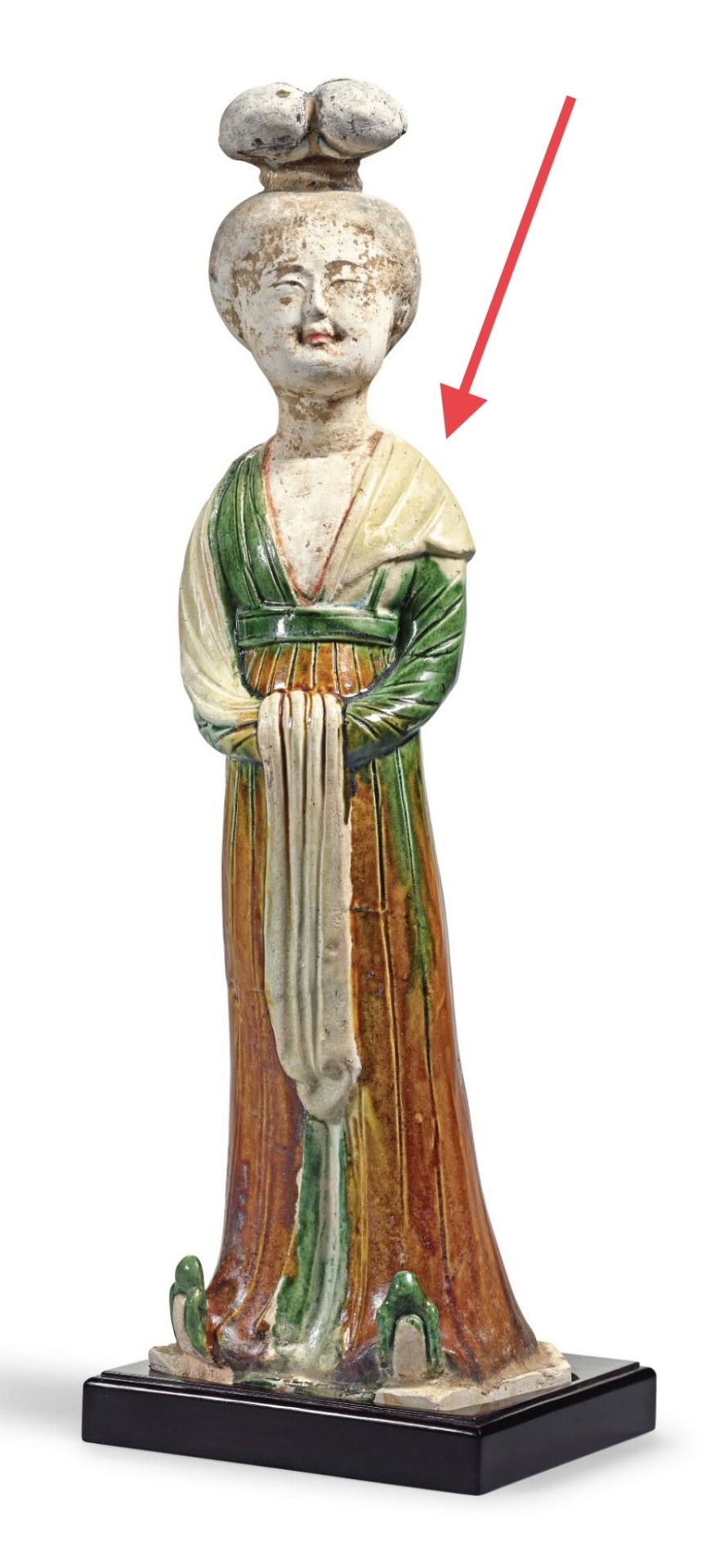
A sancai-glazed figure of a court lady, Tang Dynasty (618–690, 705–907 CE) from the Sze Yuan Tang Collection. Artist unknown. Sotheby’s [image source].
Although some internet sources claim that pibo in China can be traced as far back as the Qin (221-206 BCE) or Han (202 BCE–9 CE; 25–220 CE) dynasties, we don’t start seeing it be depicted as we know it today until the Northern and Southern dynasties period (420-589 CE). This has led to scholars placing pibo’s introduction to East Asia until after Buddhism was introduced in China. Despite the earliest art representations of the long scarf-like shawl coming from the Northern and Southern Dynasties period, the pibo reached its popularity apex in the Tang Dynasty (618–690 CE: 705–907 CE).
Academic consensus: Introduction via the Silk Road.
The definitive academic consensus is that pibo evolved from the dajin 搭巾 (a long and thin scarf) worn by Buddhist icons introduced to China via the Silk Road from West Asia.
披帛是通过丝绸之路传入中国的西亚文化, 与中国服饰发展的内因相结合而流行开来的一种"时世妆" 的形式. 沿丝绸之路所发现的披帛, 反映了丝绸贸易的活跃.
[Trans] Pibo (a long piece of cloth covering the back of the shoulders) was a popular female fashion period accessory introduced to China by West Asian cultures by way of the Silk Road and the development of Chinese costumes. The brocade scarves found along the Silk Road reflect the prosperity of the silk trade that flourished in China's past (Lu & Xu, 2015).
I want to add to the above theory my own speculation that, what the Chinese considered to be dajin, was most likely an ancient Indian garment called uttariya उत्तरीय.
2. Personal conjecture: Uttariya as a tentative origin to pibo.
In India, since Vedic times (1500-500 BCE), we see mentions in records describing women and men wearing a thin scarf-like garment called “uttariya”. It is a precursor of the now famous sari. Although the most famous depiction of uttariya is when it is wrapped around the left arm in a loop, we do have other representations where it is draped over the shoulders and cubital area (reverse of the elbow).
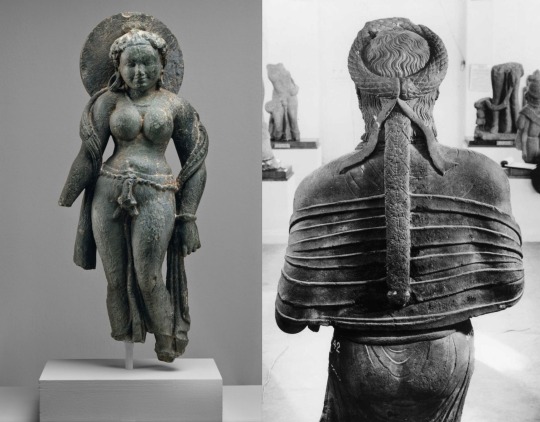
Left: Hindu sculpture “Mother Goddess (Matrika)”, mid 6th century CE, gray schist. Artist unknown. Looted from Rajasthan (Tanesara), India. Photo credit to Metropolitan Museum of Art, New York, United States [image source].
Right: Rear view of female statue possibly representing Kambojika, the Chief Queen of Mahakshatrapa Rajula, ca. 1st century CE. Artist unknown. Found in the Saptarishi Mound, Mathura, India. Government Museum, Mathura [image source].
Buddhism takes many elements from Hindu mythology, including apsaras अप्सरा (water nymphs) and gandharvas गन्धर्व (celestial musicians). The former was translated as feitian 飞天 in China. Hindu deities were depicted wearing clothes similar to what Indian people wore, among which we find uttariya, often portrayed in carvings and sculptures of flying and dancing apsaras or gods to show dynamic movement. Nevertheless, uttariya long predated Buddhism and Hinduism.
Below are carved representation of Indian apsaras and gandharvas. Notice how the uttariya are used.
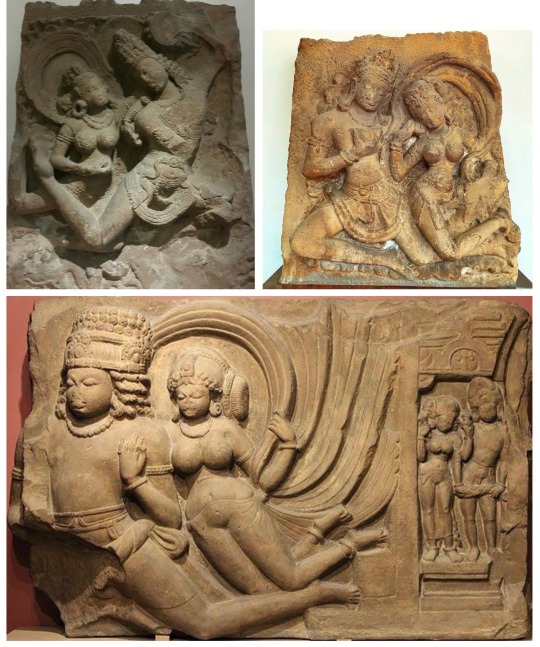
Upper left: Carved relief of flying celestials (Apsara and Gandharva) in the Chalukyan style, 7th century CE, Chalukyan Dynasty (543-753 CE). Artist Unknown. Aihole, Karnataka, India. National Museum, New Delhi, India [image source]. The Chalukyan art style was very influential in early Chinese Buddhist art.
Upper right: Carved relief of flying celestials (gandharvas) from the 10th to the 12th centuries CE. Artist unknown. Karnataka, India. National Museum, New Delhi, India [image source].
Bottom: A Viyadhara (wisdom-holder; demi-god) couple, ca. 525 CE. Artist unknown. Photo taken by Nomu420 on May 10, 2014. Sondani, Mandsaur, India [image source].
Below are some of the earliest representations of flying apsaras found in the Mogao Caves, Gansu Province, China. An important pilgrimage site along the Silk Road where East and West met.
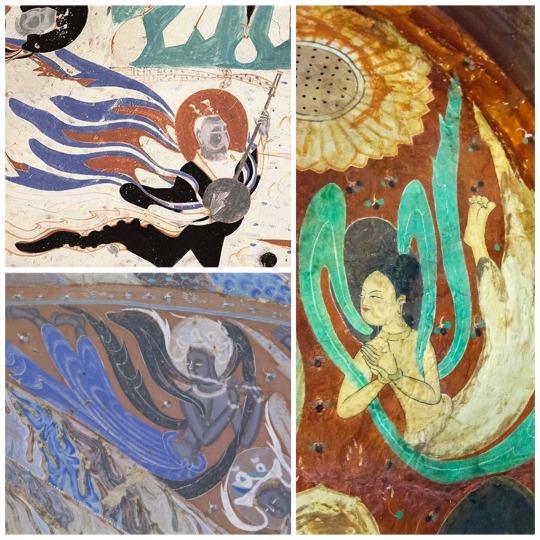
Left to right: Cave No. 461, detail of mural in the roof of the cave depicting either a flying apsara or a celestial musician. Western Wei dynasty (535–556 CE). Artist unknown. Mogao Grottoes, Dunhuang, China [image source].
Cave 285 flying apsara (feitian) in one of the Mogao Caves. Western Wei Dynasty (535–556 CE), Artist unknown. Photo taken by Keren Su for Getty Images. Mogao Grottoes, Dunhuang, China [image source].
Cave 249. Mural painting of feitian playing a flute, Western Wei Dynasty (535-556 CE). Image courtesy by Wang Kefen from The Complete Collection of Dunhuang Grottoes, Vol. 17, Paintings of Dance, The Commercial Press, Hong Kong, 2001, p. 15. Mogao Grottoes, Dunhuang, China [image source].
I theorize that it is likely that the pibo was introduced to China via Buddhism and Buddhist iconography that depicted apsaras (feitian) and other deites wearing uttariya and translated it to dajin.
3. Trickle down fashion: Buddhism’s journey to the East.
However, since Buddhism and its Indian-based fashion spread to West Asia first, to Sassanian Persians and Sogdians, it is likely that, by the time it reached the Han Chinese in the first century CE, it came with Persian and Sogdian influence. Persians’ fashion during the Sassanian Empire (224–651 CE) was influenced by Greeks (hellenization) who also had a a thin long scarf-like garment called an epliblema ἐπίβλημα, often depicted in amphora (vases) of Greek theater scenes and sculptures of deities.
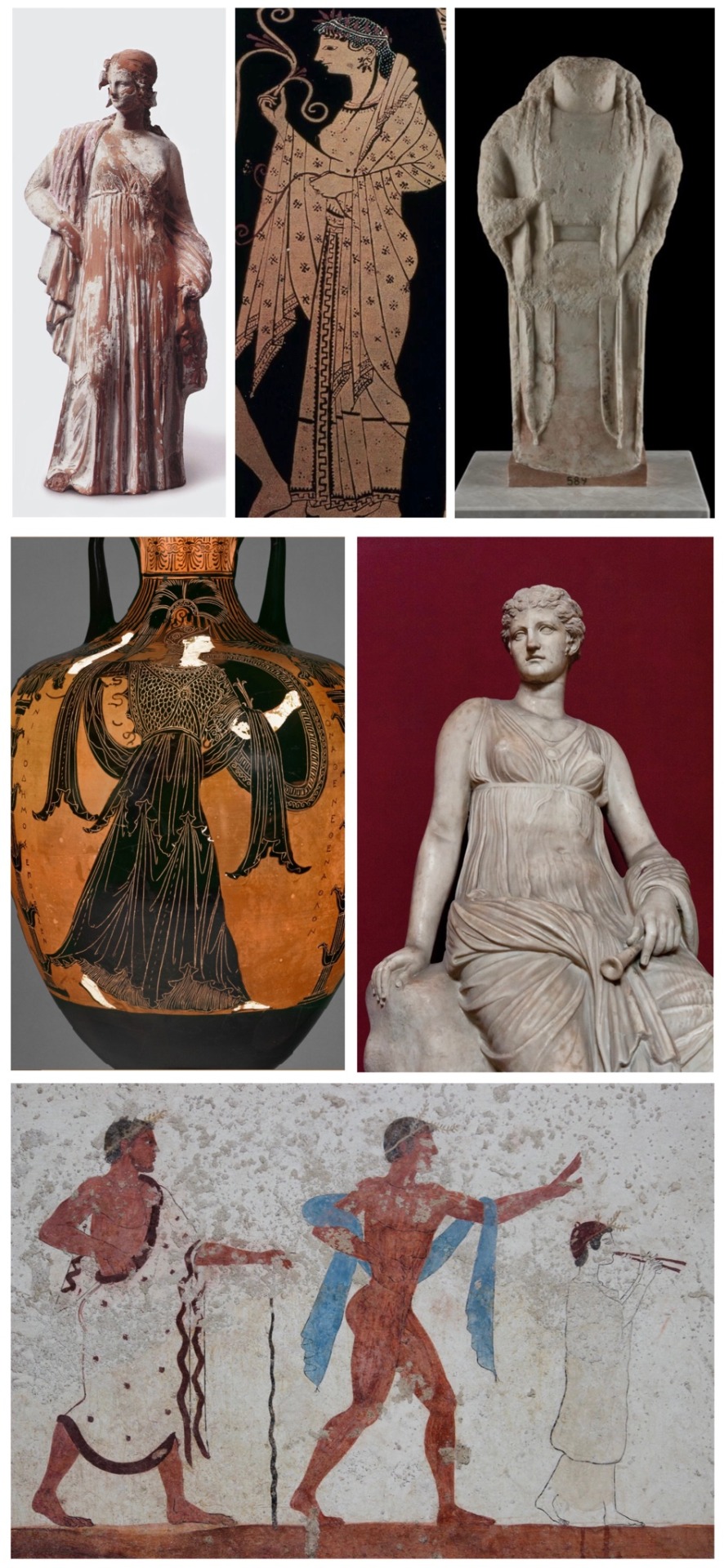
Left to right: Dame Baillehache from Attica, Greece. 3rd century BCE, Hellenistic period (323-30 BCE), terracotta statuette. Photo taken by Hervé Lewandowski. Louvre Museum, Paris, France [image source].
Deatail view of amphora depicting the goddess Artemis by Athenian vase painter, Andokides, ca. 525 BCE, terracotta. Found in Vulci, Italy. Altes Museum, Berlin, Germany [image source].
Statue of a Kore (young girl), ca. 570 BCE, Archaic Period (700-480 BCE), marble. Artist unknown. Uncovered from Attica, Greece. Acropolis Museum, Athens, Greece [image source].
Detail view of Panathenaic (Olympic Games) prize amphora with lid, 363–362 BCE, Attributed to the Painter of the Wedding Procession and signed by Nikodemos, terracotta. Uncovered from Athens, Greece. J. Paul Getty Museum, Los Angeles, California, United States [image source].
Roman statue depicting Euterpe, muse of lyric poetry and music, ca. 2nd century CE, marble, Artist unknown. From the Villa of G. Cassius Longinus near Tivoli, Italy. Photo taken by Egisto Sani on March 12, 2012, Vatican Museums, Rome, Italy [image source].
Greek (or Italic) tomb mural painting from the Tomb of the Diver, ca. 470 BCE, fresco. Artist unknown. Photo taken by Floriano Rescigno. Necropolis of Paestum, Italy [image source].
Below are Iranian and Iraqi period representations of this long thin scarf.

Left to right: Closeup of ewer likely depicting a female dancer from the Sasanian Period (224–651 CE) in ancient Persia , Iran, 6th-7th century CE, silver and gilt. Artist unknown. Mary Harrsch. July 10, 2015. Arthur M. Sackler Gallery of Asian Art, Smithsonian, Washington D.C [image source].
Ewer with nude dancer probably representing a maenad, companion of Dionysus from the Sasanian Period (224–651 CE) in ancient Persia, Iran, 6th-7th century CE, silver and gilt. Artist unknown. Mary Harrsch. July 16, 2015. Arthur M. Sackler Gallery of Asian Art, Smithsonian, Washington D.C [image source].
Painting reconstructing the image of unveiled female dancers depicted in a fresco, Early Abbasid period (750-1258 CE), about 836-839 CE from Jawsaq al-Khaqani, Samarra, Iraq. Museum of Turkish and Islamic Art, Istanbul [image source].
The earliest depictions of Buddha in China, were very similar to West Asian depictions. Ever wonder why Buddha wears a long draped robe similar to a Greek himation (Romans called it toga)?
Take a look below at how much the Greeks influenced the Kushans in their art and fashion. The top left image is one of the earliest depictions of Buddha in China. Note the similarities between it and the Gandhara Buddha on the right.
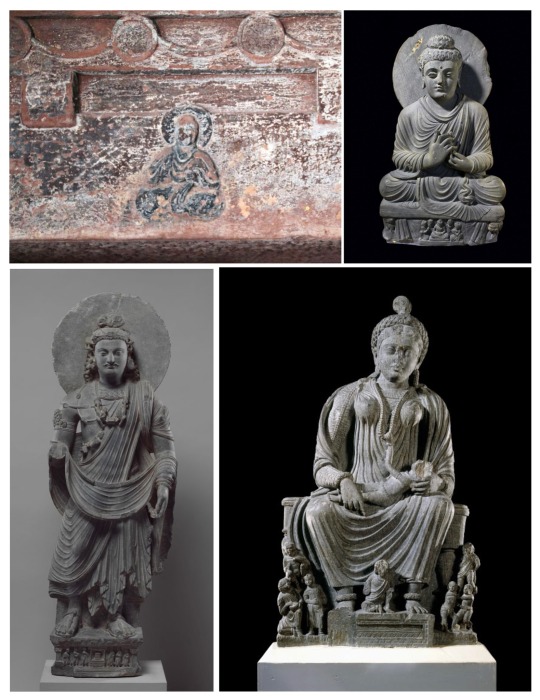
Left: Seated Buddha, Mahao Cliff Tomb, Sichuan Province, Eastern Han Dynasty, late 2nd century C.E. (photo: Gary Todd, CC0).
Right: Seated Buddha from Gandhara, Pakistan c. 2nd–3rd century C.E., Gandhara, schist (© Trustees of the British Museum)
Standing Bodhisattva Maitreya (Buddha of the Future), ca. 3rd century, gray schist. From Gandhara, Pakistan. Image credit to The Metropolitan Museum of Art, New York City, United States [image source].
Statue of seated goddess Hariti with children, ca. 2nd to 3rd centuries CE, schist. Artist unknown. From Gandhara, Pakistan. The British Museum, London, England [image source].
Before Buddhism spread outside of Northern India (birthplace), Indians never portrayed Buddha in human form.
Early Buddhist art is aniconic, meaning the Buddha is not represented in human form. Instead, Buddha is represented using symbols, such as the Bodhi tree (where he attained enlightenment), a wheel (symbolic of Dharma or the Wheel of Law), and a parasol (symbolic of the Buddha’s royal background), just to name a few. […] One of the earliest images [of Buddha in China] is a carving of a seated Buddha wearing a Gandharan-style robe discovered in a tomb dated to the late 2nd century C.E. (Eastern Han) in Sichuan province. Ancient Gandhara (located in present-day Afghanistan, Pakistan, and northwest India) was a major center for the production of Buddhist sculpture under Kushan patronage. The Kushans occupied portions of present-day Afghanistan, Pakistan, and North India from the 1st through the 3rd centuries and were the first to depict the Buddha in human form. Gandharan sculpture combined local Greco-Roman styles with Indian and steppe influences (Chaffin, 2022).
In the Mogao Caves, which contain some of the earliest Buddhist mural paintings in China, we see how initial Chinese Buddhist art depicted Indian fashion as opposed to the later hanfu-inspired garments.
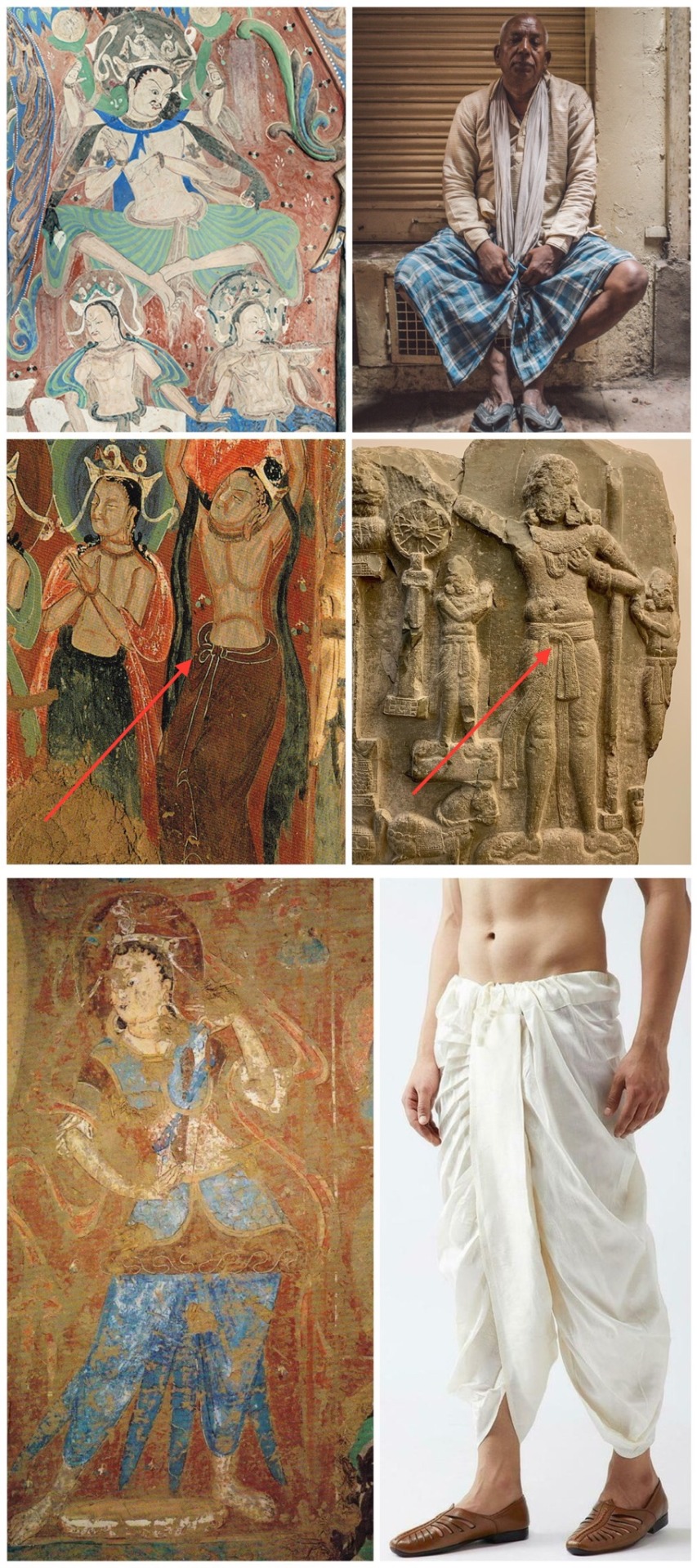
Left to right: Cave 285, detail of wall painting, Western Wei dynasty (535–556 CE). Mogao Grottoes, Dunhuang, China. Courtesy the Dunhuang Academy [image source]. Note the clothes the man is wearing. It looks very similar to a lungi (a long men’s skirt).
Photo of Indian man sitting next to closed store wearing shirt, scarf, lungi and slippers. Paul Prescott. February 20, 2015. Varanasi, India [image source].
Cave 285, mural depiction of worshipping bodhisattvas, 6th century CE, Wei Dynasty (535-556 A.D.), Unknown artist. Mogao Grottoes, Dunhuang, China. Notice the half bow on his hips. That is a common style of tying patka (also known as pataka; cloth sashes) that we see throughout Indian history. Many of early Chinese Buddhist paintings feature it, including the ones at Mogao Caves.
Indian relief of Ashoka wearing dhoti and patka, ca. 1st century BC, Unknown artist. From the Amaravathi village, Guntur district, Andhra Pradesh, India. Currently at the Guimet Museum, Paris [image source].
Cave 263. Mural showing underlying painting, Northern Wei Dynasty (386–535 CE). Artist Unknown. Picture taken November 29, 2011, Mogao Grottoes, Dunhuang, China [image source]. Note the pants that look to be dhoti.
Comparison photo of modern dhoti advertisement from Etsy [image source].
Spread of Buddhism to East Asia.

Map depicting the spread of Buddhism from Northern India to the rest of Asia. Gunawan Kartapranata. January 31, 2014 [image source]. Note how Mahayana Buddhism arrived to China after passing through Kushan, Bactrean, and nomadic steppe lands, absorbing elements of each culture along the way.
Wealthy Buddhist female patrons emulated the fantasy fashion worn by apsaras, specifically, the uttariya/dajin and adopted it as an everyday component of their fashion.
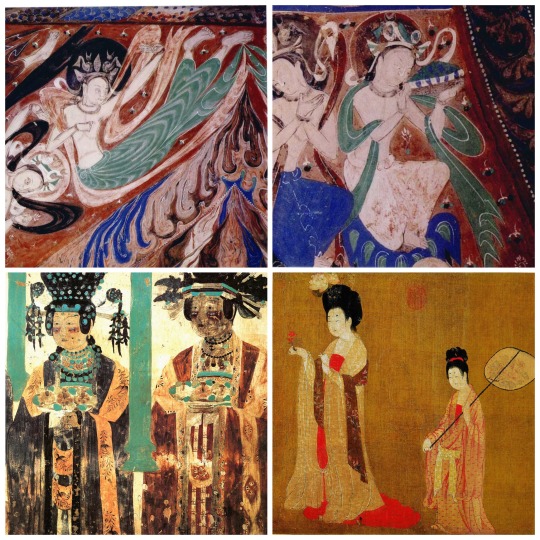
Cave 285. feitian mural painting on the west wall, Western Wei Dynasty (535–556 CE). Artist unknown. Mogao Grottoes, Dunhuang, China [image source].
Cave 285. Detail view of offering bodhisattvas (bodhisattvas making offers to Buddha) next to the phoenix chariot on the Western wall of the cave. Western Wei Dynasty (535–556 CE). Artist unknown. Mogao Grottoes, Dunhuang, China [image source].
Cave 61 Khotanese (from the kingdom of Khotan 于阗 [56–1006 CE]) donor ladies, ca. 10th century CE, Five Dynasties period (907 to 979 CE). Artist unknown. Picture scanned from Zhang Weiwen’s Les oeuvres remarquables de l'art de Dunhuang, 2007, p. 128. Uploaded to Wikimedia Commons on October 11, 2012 by Ismoon. Mogao Grottoes, Dunhuang, China [image source].
Detail view of Ladies Adorning Their Hair with Flowers 簪花仕女图, late 8th to early 9th century CE, handscroll, ink and color on silk, Zhou Fang 周昉 (730-800 AD). Liaoning Provincial Museum, Shenyang, China [image source].
Therefore, the theory I propose of how the pibo entered East Asia is:
India —> Greek influenced West Asia (Sassanian Persians, Sogdians, Kushans, etc…) —> Han China —> Rest of East Asia (Three Kingdoms Korea, Asuka Japan, etc…)
Thus, the most likely theory, in my person opinion, is Buddhist iconography depicting uttariya encountered Greek-influenced West Asian Persian, Sogdian, and Kushan shawls, which combined arrived to China but wouldn’t become commonplace there until the explosion in popularity of Buddhism from the periods of Northern and Southern Dynasties to Song.
References:
盧秀文; 徐會貞. 《披帛與絲路文化交流》 [The brocade scarf and the cultural exchanges along the Silk Road]. 敦煌研究 (中國: 敦煌研究編輯部). 2015-06: 22 – 29. ISSN 1000-4106.
#hanfu#chinese culture#chinese history#buddhism#persian#sogdian#kushan#gandhara#indian fashion#uttariya#pibo#history#asian culture#asian art#asian history#asian fashion#east asia#south asia#india#pakistan#iraq#afghanistan#sassanian#silk road#fashion history#tang dynasty#eastern han dynasty#cultural exchange#greek fashion#mogao caves
299 notes
·
View notes
Text
Hey, guys! Want to vote on the best 6th-10th Century script (writing system) that I, Gecko, personally like?
Of course you do! Writing systems are SO COOL!
And here's a bit about each of the contenders:
Arabic (Naskh Script)
Derived from the Aramaic Script, which grew out of Phoenician, Arabic has a variety of forms. The Naskh script is the one I find the most beautiful, with it's extreme variation on character length and height. I also love the use of multiples colours for Ḥarakāt (vowel marks and other diacritics). Add in the elegant curves and solid lines, and Naskh Script becomes one of the most stylish scripts around.
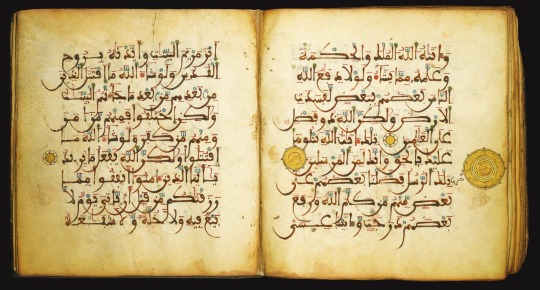
Latin (Insular Script)
Derived from Greek, the Latin alphabet is usually a competent and pleasant mix of lines and curves, uprights and descenders. Insular script plays with these qualities, and the result is electric! many of the uprights (t, d, f) are gone. New descenders are added (r, s, f). Horizontal lines take a new prominence. Line weight is increased, and the curves become more angular. Something old to us becomes new again.

Chinese (Semi-Cursive Script)
There are many ways to write Hanzi (Chinese characters), and Semi-Cursive Script manages to combine the best qualities of most of them! The expressive curves and flow of a cursive script. The solid shapes and readability of Regular Script. One of the joys of Hanzi is the visual interest of so many unique characters; which share components, but use them differently. Semi-Cursive keeps much of that interest, while also providing a dynamic energy and movement.
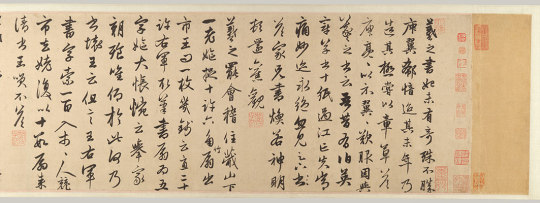
Sogdian (Cursive Script)
Derived from the Syriac script, which grew out of the Aramaic Script, the Sogdian Alphabet was developed by traders who met most of the major cultures of the Old World, and let all of those cultures affect their language and writing. Sogdian can be written write to left, like most Aramaic scripts, but also top to bottom, like the Chinese Scripts of their main trade partner. Curvy cursive lines, and characters of wildly varying length, give this script a interesting sense of flow.
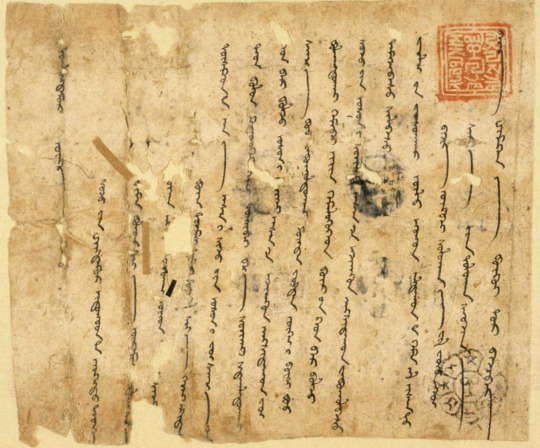
Hebrew (Ktav Ashuri Script with Palestinian Vocalization)
Another offshoot of the (Imperial) Aramaic Script, the Hebrew Alphabet has a really interesting, heavy, square, solid feel. In contrast, Palestinian Voicing (an extinct form of writing vowels where all of them were above the consonants) is really light, stacked on top their vowels in little floaty towers. It's a cool combination!
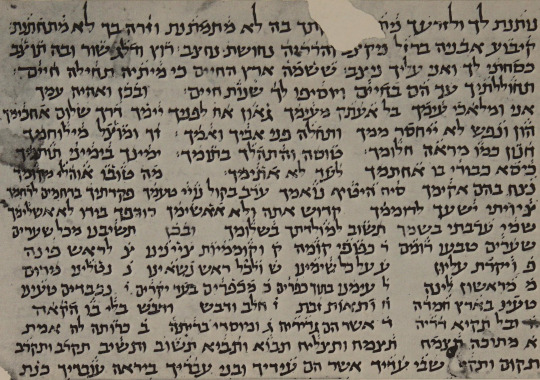
Maya (Classical Maya Script)
The most famous script of the Americas, Maya has one of the most unique reading orders of any script. Characters are written in blocks, which are then read in a zigzag (right, and then down-left) pattern. Full of heads (both animal and human), torches, seeds, and other half-identifiable shapes, Maya texts are works of art, and the more you study them, the more beautiful they become.
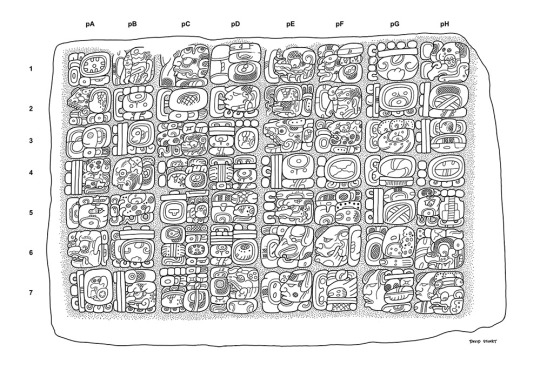
Nubian (Old Nubian Script)
Derived from Greek with additional letters from Coptic (Egyptian) and Meroitic (a previous Nubian culture). Lines above letters are used to skip parts of words deemed unnecessary. The mixture of rectangles and triangles, heavy and light line weights - it reminds me of telegrams, or early typewriter text. I love it!
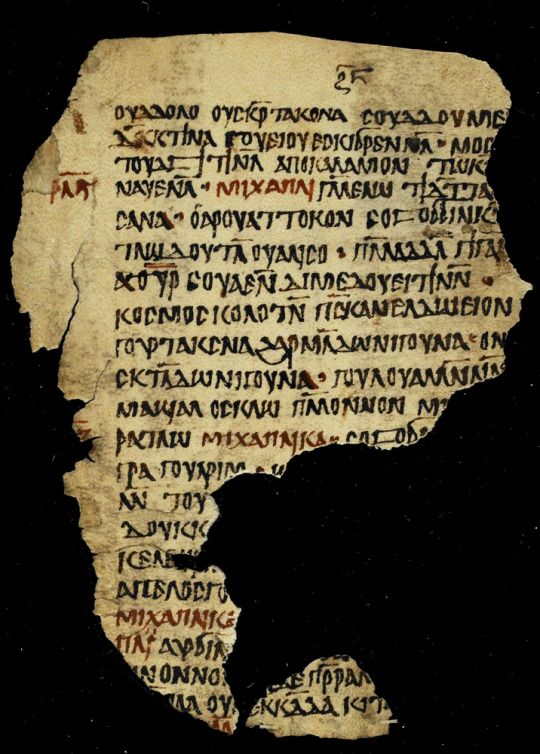
Khmer (Angkorian Khmer Script)
Derived from the Pallava Script, which derived from the Brahmi Script, Khmer is probably my favourite script to write. The curves feel so good! The spirals so pleasing! You write consonant clusters by writing little letters below the main one! A joy to create, and a joy to look at.
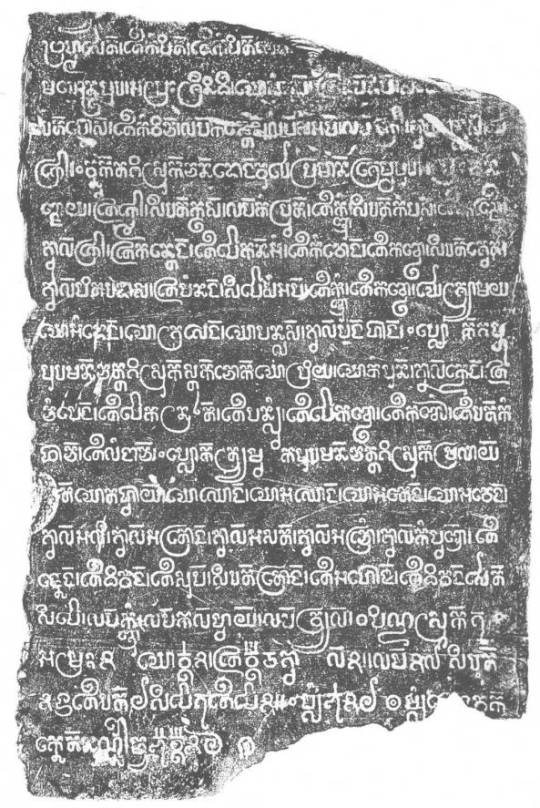
Japanese (Cursive Script)
See these wiggles? They're Chinese characters. Elegant, looking like poetry no matter what they're saying, Cursive Japanese is art. It's also ridiculous. 3 different characters, each with multiple strokes, indicated by wiggling the brush as you draw a line! Most cursive scripts are like this, but the contrast between the square solidness of Regular Script and the flow of Cursive is one of the more extreme. What a delight!
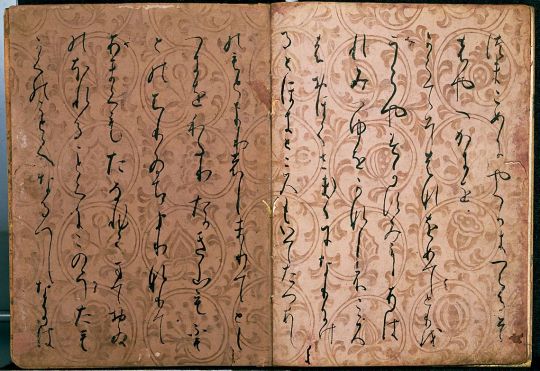
Sanskrit (Siddham Script)
I had SO MANY options for Sanskrit (Brahmi) Scripts, you guys. SO MANY! But in north-west India, during the period I study, this version of Siddham is the prettiest. Look at the curves! Those aren't just decorative, each curvy line that goes above or below the text is a vowel. Consonant clusters are shown by combining the characters together in one spot. The lines at the top haven't yet started connecting, like they do in modern Devanagari, but there's already a sense of it's existence. Such a cool script!
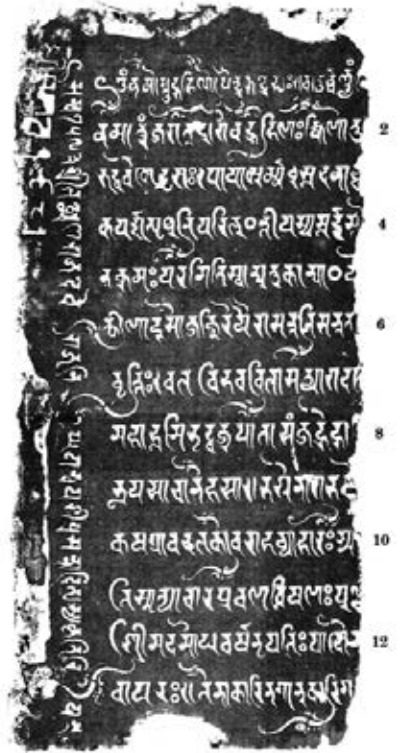
#long post#gecko's polls#calligraphy#scripts#writing systems#arabic#hebrew#khmer#maya#latin#nubian#sanskrit#sogdian#chinese#japanese
231 notes
·
View notes
Text

"I'd rather be a dog’s or a pig’s wife than yours!" In this 4th-c. letter, a Sogdian woman writes to the husband who abandoned her in Dunhuang. Alas, it was found in a lost postbag and never reached its recipient!"
International Dunhuang Programme:
https://x.com/idp_uk/status/1275715285606182914
17 notes
·
View notes
Text
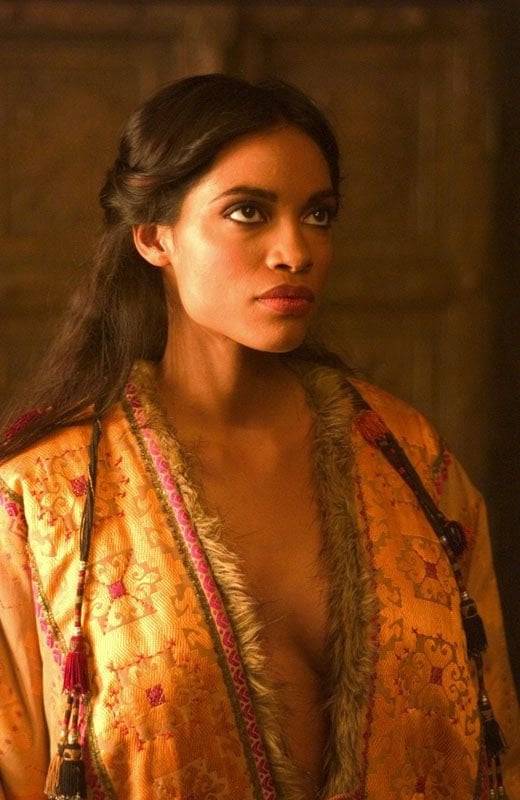


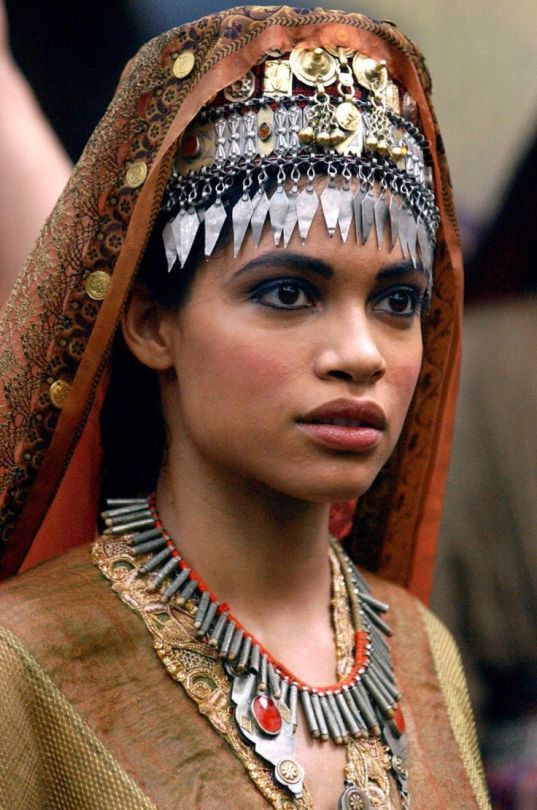


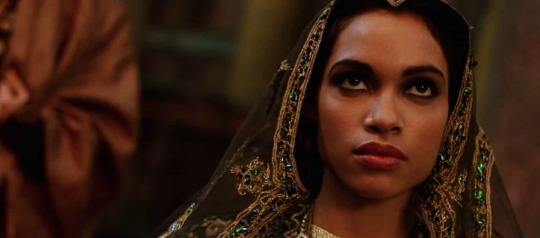
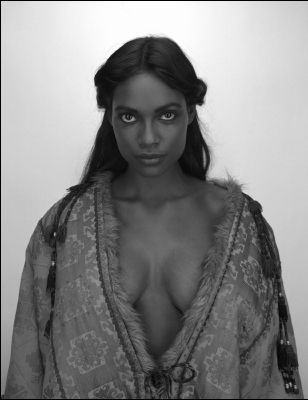
"...WHAT LITTLE WE DO KNOW IS HIGHLY CONTENTIOUS ABOUT WHETHER OR NOT SHE WAS SOMEONE WHO WAS THE LOVE OF HIS LIFE..."
PIC(S) INFO: Spotlight on American actress Rosario Dawson as Roxana (340-310 BC) in the epic historical drama "Alexander" (2004), directed by Oliver Stone. Roxana was a Sogdian princess of Bactria, the wife of Alexander the Great, and the mother of Alexander IV of Macedon.
Costume design: Jenny Beavan
Cinematography: Rodrigo Prieto
Production design: Jan Roelfs
BLACK FILM: "How much is known about Roxane from a historical point of view?"
RD: "Very little. There's very little [background] about her. We know more about Begolas than we know about her, and what little we do know is highly contentious about whether or not she was someone who was the love of his life or was someone who he just married because he'd already had his good standing in the area and it was a political move, or because he really just wanted an heir and suddenly got impatient to have one, all of which besides there being a strong emotional dynamic seems very unlikely. I mean, he just overthrew the Persian empire -- he doesn't exactly need Oxyardies' help, and he kind of went several years into his campaign of warring without securing an heir, and he didn't secure one that was Macedonian or Greek, which really upset a lot of his companions. He married this woman, and it was a very strange thing in part of his history and Oliver's sort of expression of what that must have been like was because of her spirit and sort of the Oedipal complex that came out because she reminded him of his mother."
-- BLACK FILM, "Alexander": An Interview with Rosario Dawson, by Todd Gilchrist, c. November 2004
Sources: www.pinterest.com/pin/59320920068387177 (all found on Pinterest) & www.blackfilm.com/20041119/features/rosariodawson.shtml.
#Rosario Dawson#Roxane#Period Drama#Costume Drama#Alexander 2004 Movie#Hollywood Actress#Perfect Female Body#Alexander 2004#Costume/Period Drama#Historical Epic#Alexander Movie 2004#Female body#Female figure#Female form#Sogdian Princess#Costume Epic#Roxana#Feminine beauty#Epic Historical Drama#Costume/Historical Epic#Costume Design#Actress#Movie Actress#Film Actress#2004
29 notes
·
View notes
Text

Manichaean cosmogonic text, Sogdian language in Manichaean script, Khocho, 9-10th century CE.
5 notes
·
View notes
Text

✧・゚:*Today’s magical girl of the morning is: Sogdian Night from Magical Girls (GREE)!✧・゚:*
#Sogdian Night#Magical Girls (GREE)#mobage#discontinued#purple#purple hair#hat#magical girl#magical girl of the day#mahou shoujo
6 notes
·
View notes
Text






finally finished this lapel coat... inspired by Sogdian sources at Panjikent and patterning from the Alanic Moschevaya Balka finds. fabric is pure silk, damask with brocade trim and plain brown taffeta lining
14 notes
·
View notes
Text
Ancient Iranian Peopel: Sogdians

The Sogdians were an ancient Iranian people who inhabited the region of Sogdiana, which is located in present-day Uzbekistan and Tajikistan. They played a significant role in the cultural and economic exchanges along the Silk Road, serving as intermediaries between the East and the West.
Here are some key points about the Sogdian people:
History: The Sogdians were part of the larger Iranian peoples and had a rich history that dates back to at least the 6th century BCE. They established city-states in the fertile valleys of Central Asia, forming a prosperous and cosmopolitan society.
Silk Road Traders: Sogdiana was strategically located along the Silk Road, the ancient trade route that connected China to the Mediterranean. The Sogdians became renowned traders, controlling key points along the route and facilitating the exchange of goods and ideas between the East and the West. They played a vital role in the transmission of Chinese, Indian, Persian, and Hellenistic cultures.
Economic Power: The Sogdians accumulated substantial wealth through their involvement in trade. They specialized in long-distance commerce, transporting goods such as silk, spices, precious stones, and other luxury items across vast distances. Their mastery of commercial networks and languages allowed them to establish thriving trading colonies and to dominate the Silk Road's commerce.
Cultural Influences: The Sogdians were not just traders but also cultural intermediaries. They adopted and transmitted various cultural influences from different regions they encountered, blending elements of Persian, Hellenistic, Indian, and Chinese cultures. Sogdian art, language, and religious practices, including Zoroastrianism and later Buddhism and Manichaeism, were strongly influenced by these interactions.
Sogdian Art and Writing: Sogdian artists were renowned for their exquisite artwork, particularly in metalwork, painting, and ceramics. They created intricate and vibrant motifs that incorporated both local and foreign influences. The Sogdians also developed their own script, known as the Sogdian script, which was an important precursor to the Uighur script used in Central Asia.
Decline: The Sogdian civilization faced significant challenges over time. In the 8th and 9th centuries, Arab Muslim conquests swept through the region, leading to the decline of Sogdiana as a political and economic power. The gradual Islamization of the area further eroded Sogdian culture and traditions.
Today, the Sogdians and their civilization are no longer in existence, but their legacy lives on through archaeological discoveries and ancient texts. The study of Sogdiana and its people provides valuable insights into the complexities of cultural exchange and the historical significance of the Silk Road.
Read More About Sogdians:
Ancient Iranian Language: Sogdian
Follow my YouTube channel. Silent tablets documentary, short videos from ancient history.
Follow my Twitter.
#ancient mesopotamia#mesopotamia#archaeology#ancient history#iranian#ancient iran#iranian languages#iran#iranian peopel#sogdian language#sogdian#tajikistan#uzbekistan
4 notes
·
View notes
Note
So what is the deal with Feminine Tishtrya in Sogdia? Lilla Russell-Smith in her paper on the "Sogdian Daena" painting says that Tishtrya is depicted as feminine in Sogdian art up until Islamization, but I'm having a hard time finding those examples. I know of some Sogdian influenced Chinese astrological icons that depict a Tish-influenced Mercury as feminine, but none from Sogdia itself
Great question, as usual. I’ve been obsessed with the supposed attestations of feminine Tishtrya for a bit over a year by now, so thanks for giving me an opportunity to talk more about this topic. I feel obliged to let you know right away there’s no major conclusion to draw, though.
To begin with, ultimately there is only a single indisputable depiction of more or less feminine Tish(trya)/Tir(iya), and it’s Kushan rather than Sogdian. On a coin of Huvishka only known from a single exemplar, a feminine figure armed with a bow is labeled as Teiro (TEIPO):

The feminine Teiro on a coin, British Museum (note the catalog erroneously identifies the deity as Nana despite the inscription clearly reading TEIPO…); reproduced here for educational purposes only
More under the cut.
Michael Shenkar (Intangible Spirits and Graven Images, p. 149) notes that this version of Tir/Tishtrya (I’ll try to stick to gender neutral terms through the response if you don’t mind) has been variously compared with the iconography of Artemis, Apollo and Nana(ya), and that the last of these three deities offers the closest parallel overall. However, he suggests this unusual image might simply reflect the association with Apollo attested further west, and that the deity is meant to be a youthful man, not a woman (p. 151).
Matteo Compareti (Literary and Iconographical Evidence for the Identification of the Zoroastrian Rain God Tishtrya in Sogdian Art, p. 117) doesn’t mention Apollo as an option, though, and concludes the iconography was evidently borrowed from Artemis. Harry Falk goes even further and suggests the Teiro coin was in fact recut from a Nanaya one of the Artemis-like variety (Kushan rule granted by Nana: the background of a heavenly legitimation, p. 290). The example he uses as evidence is indeed remarkably similar, and similarly was minted during the reign of Huvishka:

Nana on a coin of Huvishka, British Museum; reproduced here for educational purposes only.
Of course, this raises a question of how the relationship between Nana and Teiro was imagined. Based on the attested equivalence between their western counterpart and Nabu it is generally accepted they formed a couple, but this doesn’t really explain why they would be depicted so similarly, especially given that character-wise Nanaya has very little in common with them. As far as I am aware no serious attempts have been made to explain this, though I’ll return to this matter for a bit later on.
While I don’t necessarily think Shenkar is wrong to be skeptical about the gender of Teiro, I will note a difference in gender between western and eastern versions of an Iranian deity would not be unparalleled - Vanant is male in the Avesta, and I’m pretty sure the same holds true for Middle Persian sources, but on Kanishka’s coins the cognate name “Oanindo” (OANINΔO) pretty clearly designates a goddess visually patterned after winged Nike (Intangible spirits, p. 151-152). Drvaspa’s eastern counterpart Lrooaspo (ΛPOOACPO), on the other hand, is male in contrast with the female Avestan version (p. 96-97). Shenkar himself admits that “it is easy to envisage the same divinities being perceived not only as having different functions, but also being of different sex” (p. 97).
That’s essentially it for the Kushan evidence.
As for Sogdia - there’s quite a large repertoire of deities in Sogdian art who appear fairly consistently, but are not provided with any textual identifications, in contrast with Kushan art where everyone is neatly labeled.It’s probably safe to assume that some depictions of Tish are available to us already, and simply have yet to be identified with certainty. An argument in favor of this would be Tish’s popularity reflected in theophoric names - if Nanaya, Weshparkar or Sraosha can serve as parallels for comparative purposes, it does seem popular devotion translated into being commonly depicted in art as well.
For specific candidates, I’ll go back to Literary and Iconographical Evidence (...), since it's the most recent I have. The core criteria for identifying depictions of Tish in Sogdian art Compareti uses is fairly sound. Based on the commonly accepted assumption that they were closely associated with Nana(ya), armored figures holding objects which might be arrows (an attribute of Tish as a divine archer) appearing alongside her in paintings, ossuaries etc. are identified as Tish (p. 111-115). While the state of preservation and quality of reproductions in literature often leave a lot to be desired, I do think it’s fair to speak of the companion of Nana as a distinct entity iconographically, and I’m not aware of any identification with an equal number of supporters as Tish. Therefore, it seems safe to say these examples listed by Compareti are indeed them:




I’m less sure about the proposed identification of a golden clasp from Tillia Tepe with a pair of hugging(?) deities as a forerunner and early example of pairing Nana and Tish, since neither deity here really has any distinct attributes, and as Comparati himself notes it is generally assumed that it’s a depiction of Dionysus and Ariadne (presumably on a very stylized big cat, if so):

I’m also not sure if I agree with the proposed identification between Tish and Vreshman (the Sogdian form of Vaiśravaṇa), though (p. 109). Frantz Grenet (Vaiśravaṇa in Sogdia. About the origin of Bishamon-ten. p. 283-285) prefers to identify him with Yima/Yamšo since the latter was depicted in lamellar armor, well attested as a feature of depictions of Vaiśravaṇa. in Kushan art. Shenkar (The So-Called “Fravašis” and the “Heaven and Hell” Paintings, and the Cult of Nana in Panjikent, p. 12) argues Vreshman was incorporated into Sogdian religion as himself, without identification with any other deity. The last option seems to be the most plausible one to me, since in the Sogdian translation of the Vessantara Jataka, cited by both Compareti and Grenet, Vreshman and Narayana (Vishnu) appear under their original names even though Brahma is replaced by Azruwa (Zurvan), Indra by Adhvagh (“high god”, most likely a title of Ahura Mazda), and Mahadeva/Maheshvara (Shiva) by Weshparkar.
Anyway, back to Compareti’s paper: after establishing what he assumes to be Tish’s iconography in Sogdian art, he moves to the matter of feminine Tish (p. 117-119; “Tish in a feminine attire”, “iconographies of Tish including feminine traits”).
Things get even more shaky, tragically - he argues that Tish was associated with dragons and/or vaguely dragon-like hybrid animals and that this sort of animal symbol might have been borrowed from Nabu (p. 111; this doesn’t seem implausible at all, and matches some of the works of art discussed through the article)… and makes a jump from that to suggesting that the unique goddess on a makara from Panjikent, shown below, is in fact feminine Tish (p. 118-119):

I was overjoyed at first when I read this paper because I love that painting and, as I admitted, I’m deeply invested in the search for evidence for feminine Tish. However, after a few weeks of thinking about it I must confess it feels a bit too good to be true, so some skepticism is necessary.
Compareti’s logic isn’t all that convoluted, to be fair. Essentially - if a feminine form of Tish existed (very probable based on the Kushan coin), and if Tish was associated with Nabu (consensus position), and if Nabu’s symbol possibly transferred to Tish was the mušḫuššu (once again, probable), and if the mušḫuššu was sometimes described as aquatic (p. 112; this is surprisingly true, see the RlA entry by Frans Wiggermann here, p. 456 for attestations; of note is that many of them are late) then the unique goddess on a makara might be a feminine version of Tish on what was originally a mušḫuššu-influenced dragon reinterpreted as a makara.
However, it’s hard to argue the typical elephant-headed makara in the painting resembles the mušḫuššu, which I feel poses a potential problem. It also needs to be pointed out that Shenkar mentions attempts at identifying the unique goddess as a local river deity (ex. a personification of nearby Zeravshan) with iconography patterned after Ganga (Intangible spirits, p. 170) which is less thrilling than feminine Tish but does seem fairly plausible and would offer a pretty straightforward explanation for the makara. However, Compareti proposes identifying one more Sogdian painting as feminine Tish:

I would say in this case his arguments seem stronger - the alleged feminine Tish sits on a throne supported by dragon-like hybrids which bear no particular resemblance to the distinctly accurate makara on the other painting, and while it’s hard to tell for sure given the state of preservation one of the objects held in their hands might very well be an arrow like he argues. Identification as a Sogdian form of Anahita has also been proposed, though I am not convinced by at least some of the arguments - even though it is possible to see the creatures supporting the throne as winged dogs, they sure don’t seem like beavers (even taking into account the default Middle Persian term for this animal, sag ī ābīg, means “water dog”); furthermore, there is very little evidence for worship of Anahita in Sogdia (Intangible spirits, p. 78).
Since Lilla Russel-Smith in The ‘Sogdian Deities’ Twenty Years on: A Reconsideration of a Small Painting from Dunhuang cites Compareti on p. 192 (not the same article, though) - which I assume is what you meant in your ask - presumably the images from above are meant. Ultimately not much here pertains to the matter of Tish otherwise, though I wish the topic of possible influence of the image of Sothis was explored more. Fwiw, the author states that “sex-change in deities is important for future research” specifically with regards to one of the goddesses in the painting scroll being Tish (p. 161, footnote 26) so… maybe one day.
For what it’s worth, Compareti also accepts the possibility that the deity from the Dunhuang painting discussed by Russel-Smith is Tish depicted as feminine because of the proposed influence of the image of Sothis (The So-Called “Pelliot Chinois 4518.24”. Illustrated Document from Dunhuang and Sino-Sogdian Iconographical Contacts, p. 15) Furthermore, he postulates the possibility of attribute swapping between them and Nanaya - and speculates it might be the original reason behind the emergence of feminine Tishtrya (p. 34). He also points out that a dual association with both both Sirius (perceived positively in Zoroastrian context) and Mercury (perceived negatively, as was the case with planets) could result in an ambiguous image extending also to an ambiguous gender; and, additionally, that in Mesopotamian astronomy Mercury, like Venus, could be described as both feminine and masculine (this was a way to reflect the fact they were visible both in the morning and the evening, see Erica Reiner’s Astral Magic in Babylonia, p. 6; however, I am not aware of any Mesopotamian deity who would embody this the way Ninsianna arguably embodied the ambiguous gender assigned to Venus; Nabu has nothing of that sort to offer, that’s for sure).
However, I am not sure if Compareti is outright voicing support for the existence of feminine Tish in his paper, since within a single section he flip flops between describing Tish as “depicted as a woman” (p. 18) and arguing that a feminine appearance is not necessarily an indication of gender (p. 17). He also incorrectly states that the Teiro coin from the very beginning is the only example of a Kushan depiction of a feminine form of an otherwise masculine figure (p. 19); as I already mentioned earlier, this is also attested for Vanant. The article is generally very meandering and there’s a fair share of deeply puzzling statements, to be fair (“Atargatis who was sometimes confused with Nana and Ereshkigal” on p. 32 made my eyes roll, as did “Ishtar/Aphrodite/Venus” on p. 34 in context very clearly indicating he’s talking about Mesopotamian astronomy; and I’m not sure if I want to look into a cited paper which tries to link Baal Shamin and Vaisravana).
Last but not least, let’s look into the Chinese personification of Mercury.

A Chinese depiction of Mercury as a female scribe, British Museum; reproduced here for educational purposes only.
Yu Xin in Personal Fate and the Planets: A Documentary and Iconographical Study of Astrological Divination at Dunhuang, Focusing on the "Dhāraṇī Talisman for Offerings to Ketu and Mercury, Planetary Deity of the North" mentions that in the Tang period Chinese authors were evidently aware that the Sogdian (胡) name for Mercury was Tir, and the transcription Di (滴; literally “drop”) shows up as an alternative for more common Chenxing/Shuixing in astrological texts (p. 177). He also states that personifications of astral bodies only started appearing in China in the sixth century, probably under Buddhist influence (p. 184-185), and accordingly attributes foreign origin to the iconography of Mercury (p. 186).
However, he sees Chenxing’s character (“fond of quarreling with others”, association with scribal arts, a divine messenger role) as a reflection of a hodgepodge of traits borrowed from Hermes/Mercury, Tir/Tish (only the former name is used in the article) and by extension indirectly Nabu (again p. 186). This doesn’t seem implausible, seeing as we’d be dealing not with direct transfer of a deity but with the formation of a new one from info from various astronomical and astrological treatises imported from the west and India.

Example of a Chinese depiction of Mercury from the Tang period Wuxing ji nianbaxiu shenxing tu (五星及廿八宿神形圖); Osaka Municipial Museum of art, via Yu Xin’s article.
The article doesn’t address Chenxing’s gender beyond a footnote rejecting the proposal the personified Mercury reflected the image of an archetypal palace woman (yet again p. 186, footnote 86) and a brief comment that the gender of the personification likely changed at some point (p. 188).
Since western images of Mercury - whether ancient or later (ex. in Qazwini's Aja'ib al-Makhluqat) - are generally masculine, the elusive feminine Tish definitely seems like a natural missing piece of the Chinese Mercury puzzle but I can’t tell how plausible such an influence would be, especially given the scarcity of examples of feminine Tish/Tir actually available. For what it’s worth: Compareti does argue in favor of this (The so-called (...) , p. 35-36).
To sum up: unless I missed something huge, it doesn’t seem like there is a single paper which would answer the initial question comprehensively. We still need a rigorous “What’s up with Tish’s gender, anyway?” study. I think the Kushan coin is virtually impossible to dismiss, so it’s a matter of establishing how common feminine Tish was and in what context they arose and spread - this might be wishful thinking on my part, though. Also note that since ultimately most of what I read and write pertains to Mesopotamia, I might be by default predisposed to accept the hypotheses which remind me of the common Mesopotamian phenomenon of deity gender change via association with a different deity or n-dimensional astronomical connections.
13 notes
·
View notes
Text
Chinese statuette of a Sogdian rider

ITEM Statuette of a Sogdian rider MATERIAL Pottery CULTURE Chinese, Tang Dynasty PERIOD 618 - 907 A.D DIMENSIONS 560 mm x 510 mm x 175 mm CONDITION Good condition. Includes Thermoluminescence test by Laboratory Kotalla (Reference 26PR180521) PROVENANCE Ex Belgian private collection (2022), Ex English art gallery, Ex English private collection, East Anglian, acquired from Hong Kong art market in 1990s The Tang Dynasty (618-907 AD) in China was a period of great cultural flourishing and international exchange. During this time, the Tang Empire extended its influence along the Silk Road, facilitating vibrant trade and cultural interactions with various regions, including Central Asia. The Sogdians, an ancient Iranian people, played a significant role in these exchanges as they were prominent traders along the Silk Road. Sogdian merchants established communities in Tang China, contributing to the cosmopolitan atmosphere of the dynasty. These interactions led to the assimilation of foreign elements into Tang culture, enriching it with diverse influences. One remarkable aspect of Tang-Sogdian cultural exchange is reflected in the depiction of Sogdian riders in Minqi art. Minqi, or "folk art," encompassed a wide range of popular art forms in Tang China, including pottery figurines. These figurines often depicted scenes of daily life, including various ethnic groups such as Sogdian riders. Read the full article
#ancient#ancientart#ancienthistory#artefact#artifact#ancientartifacts#antiquities#antiquity#art#artobject#china#ancientchina#ancientworld#history#classical#archaeology#chinese#tang#statuette#statue#horse#rider#sogdian#figure#figurine
1 note
·
View note